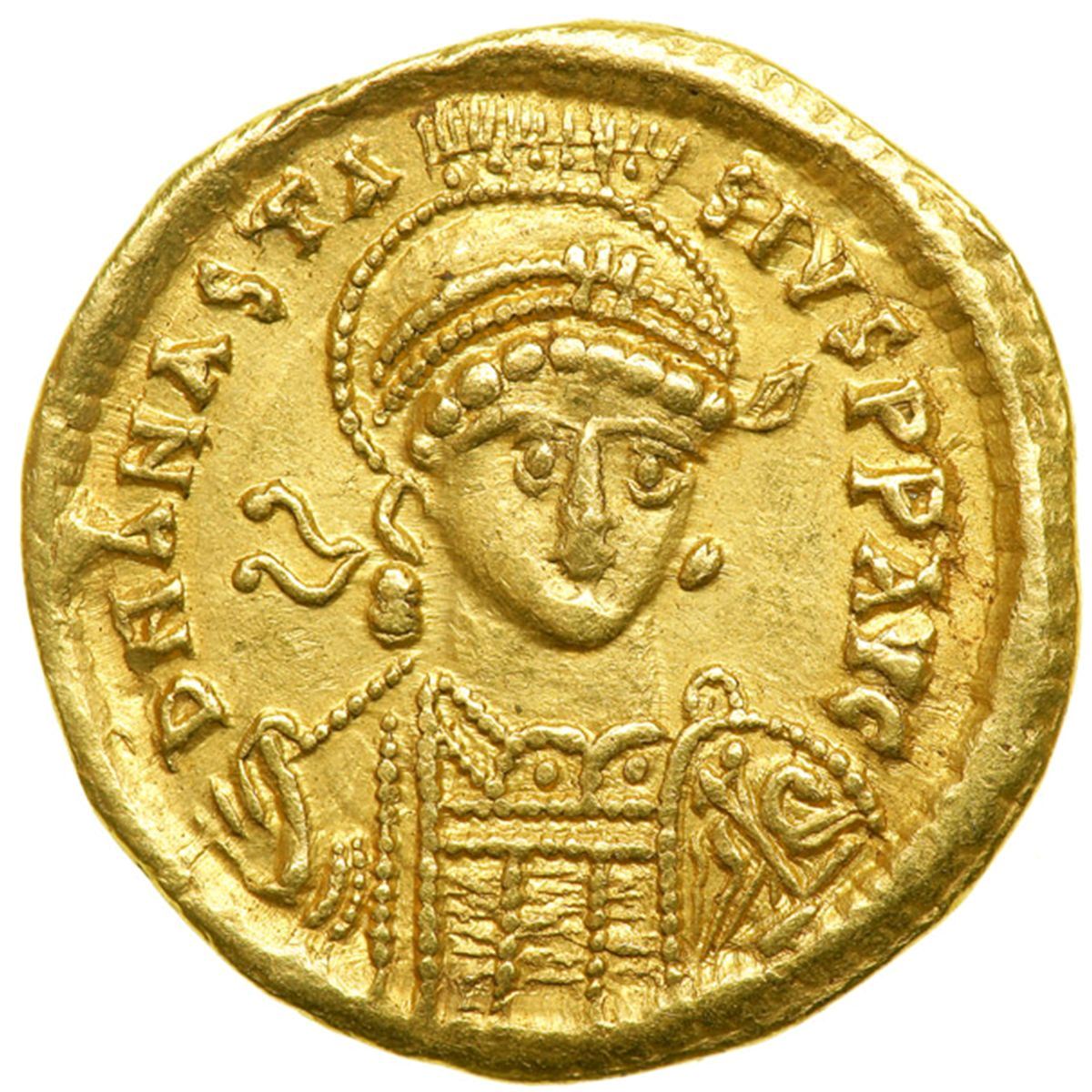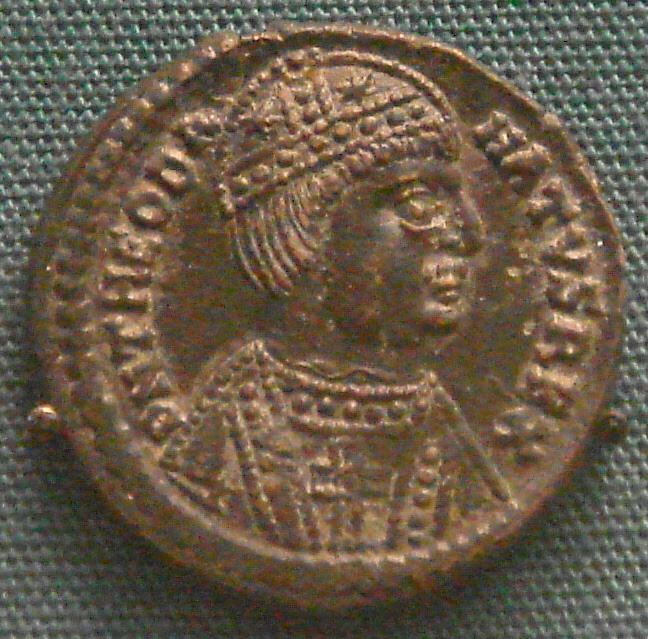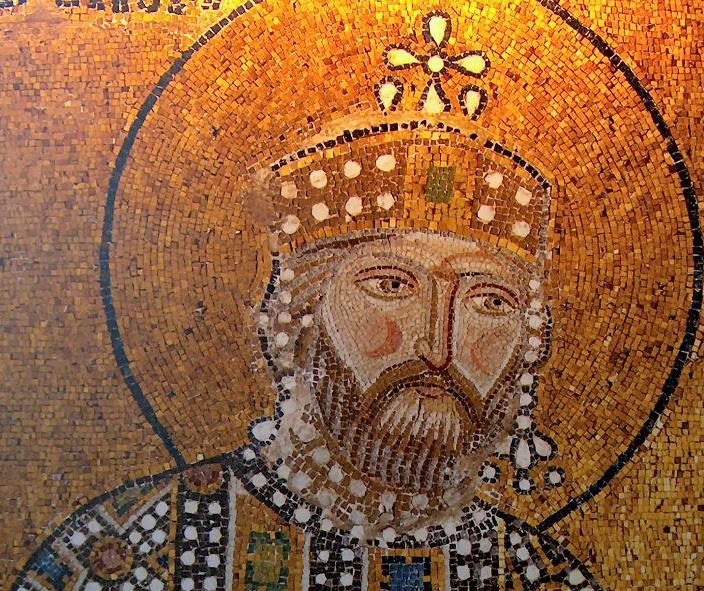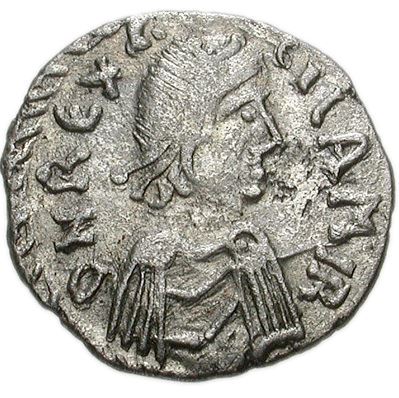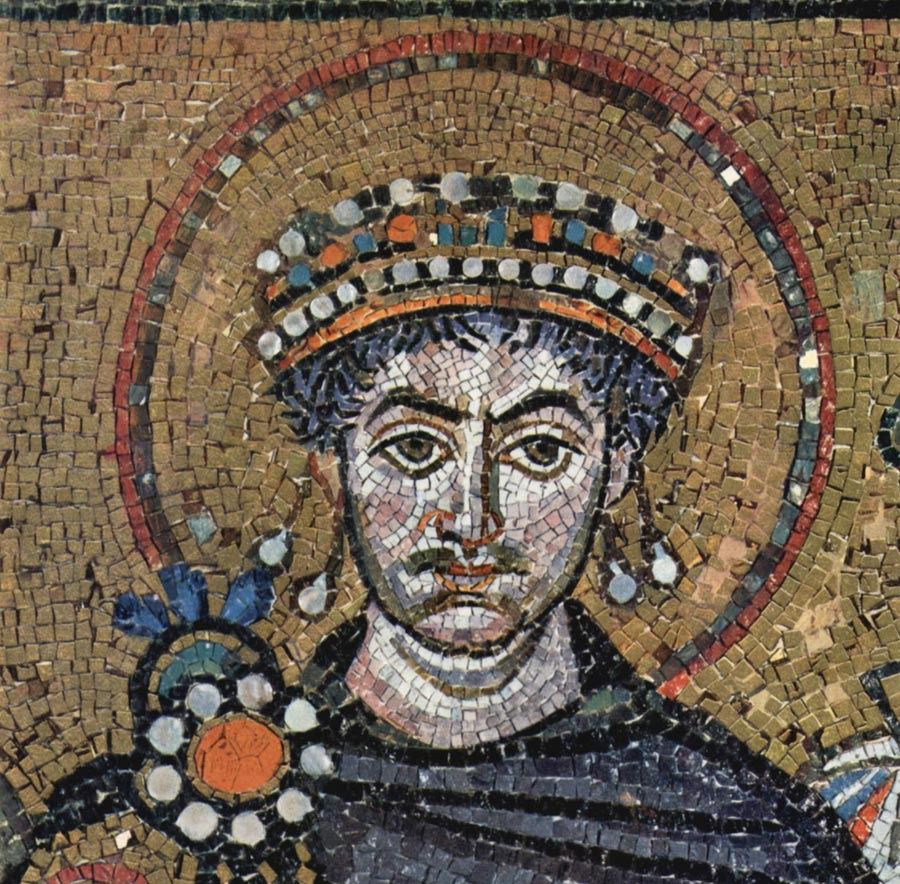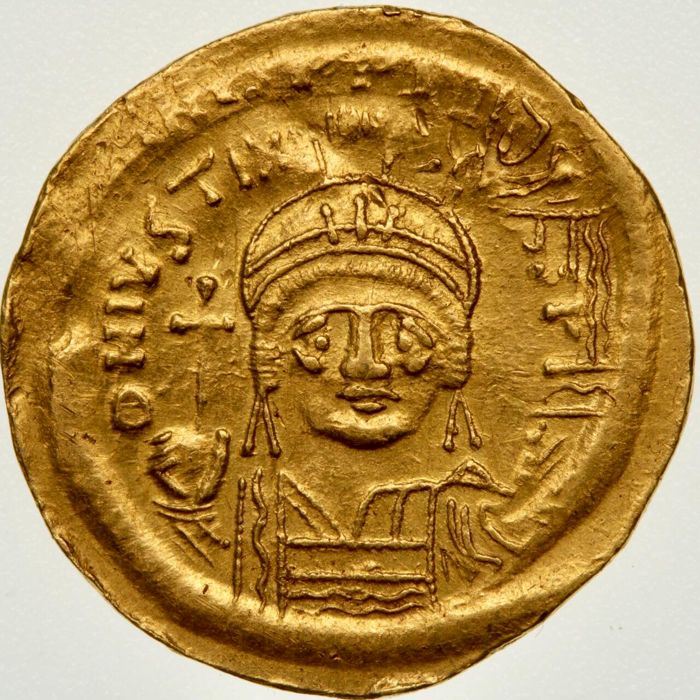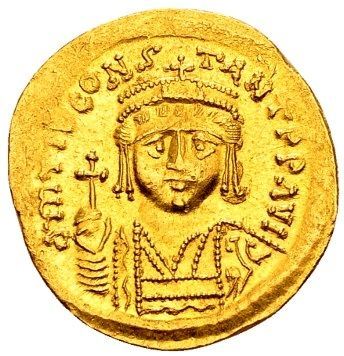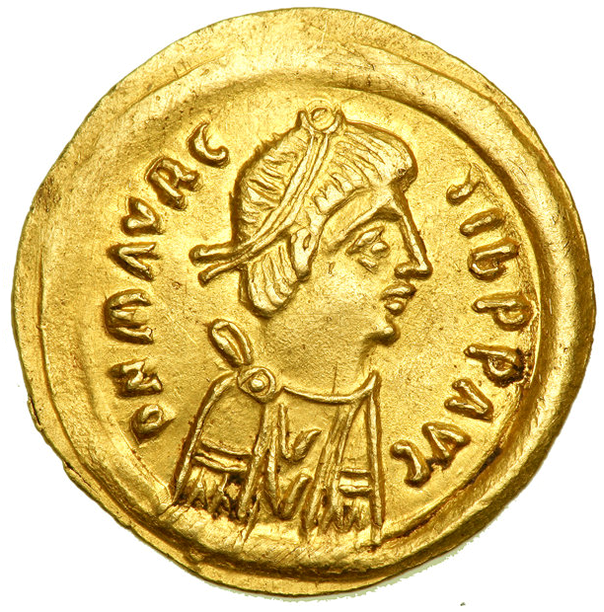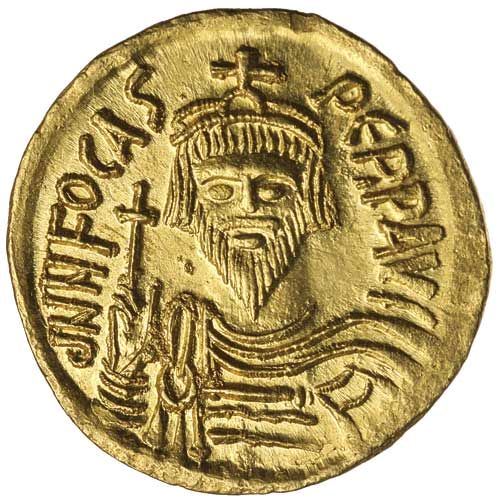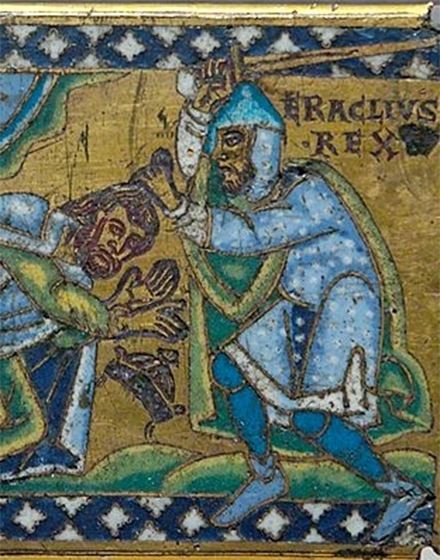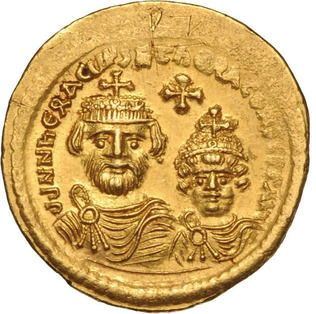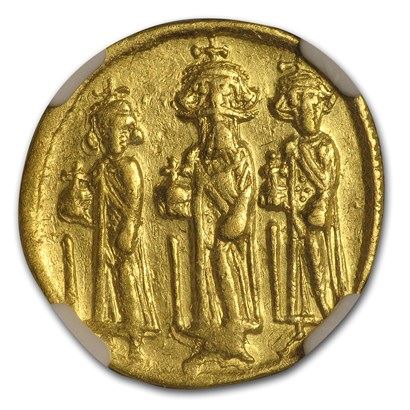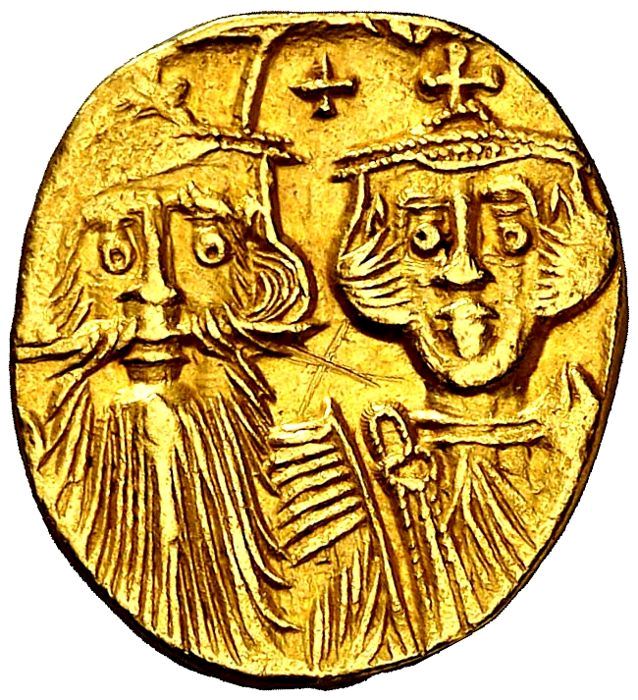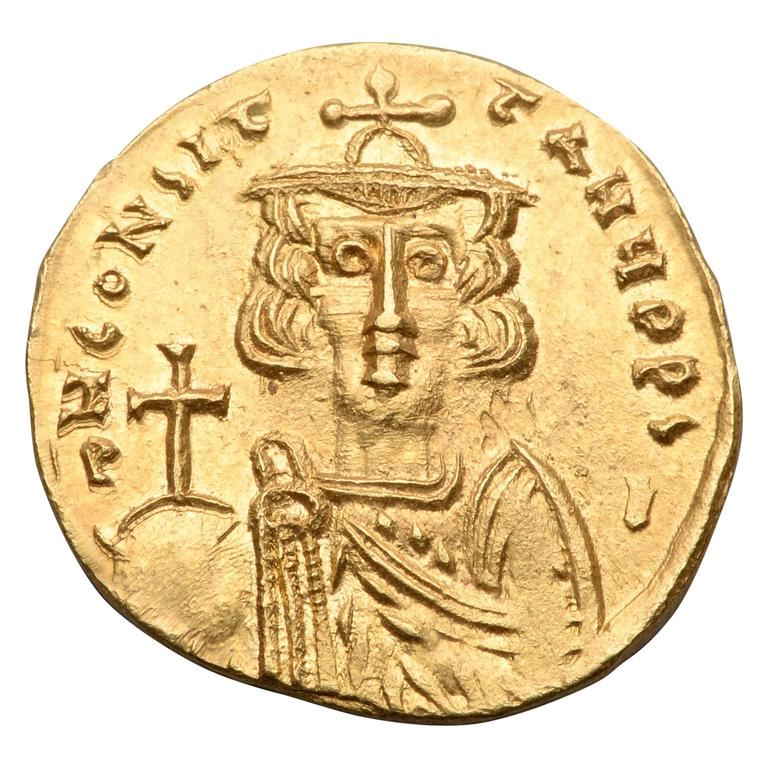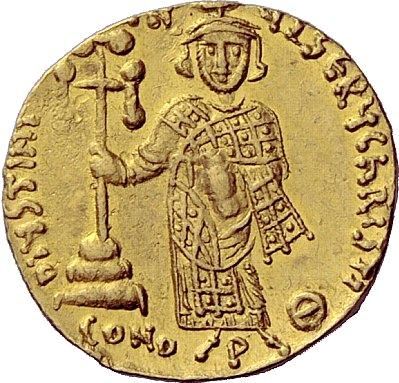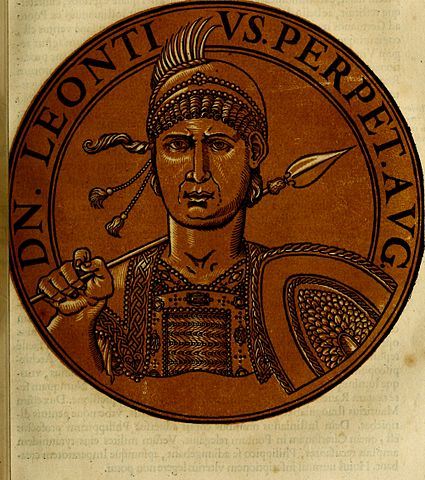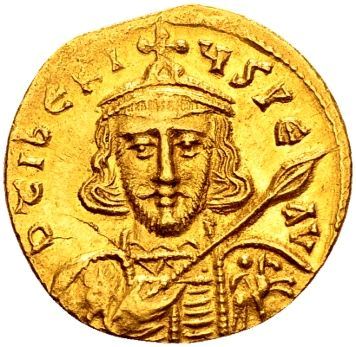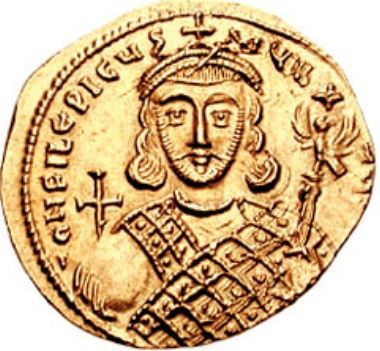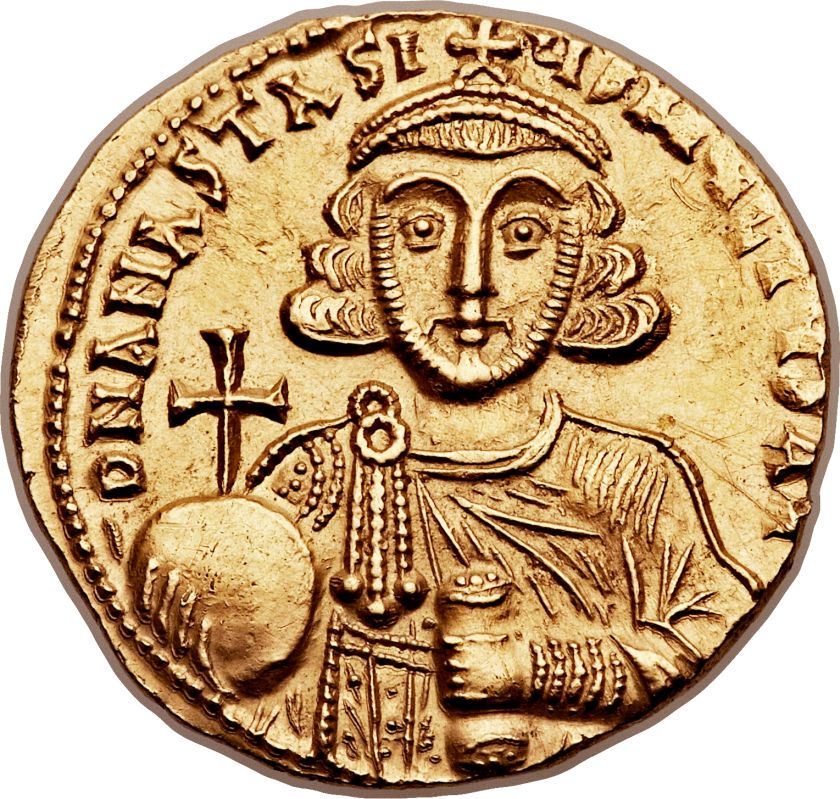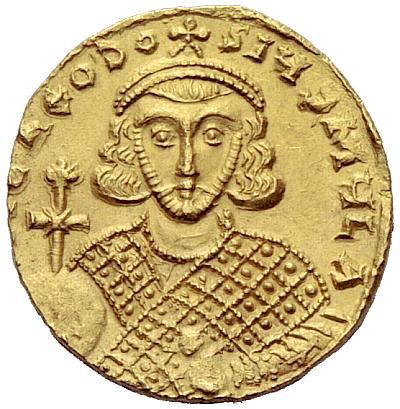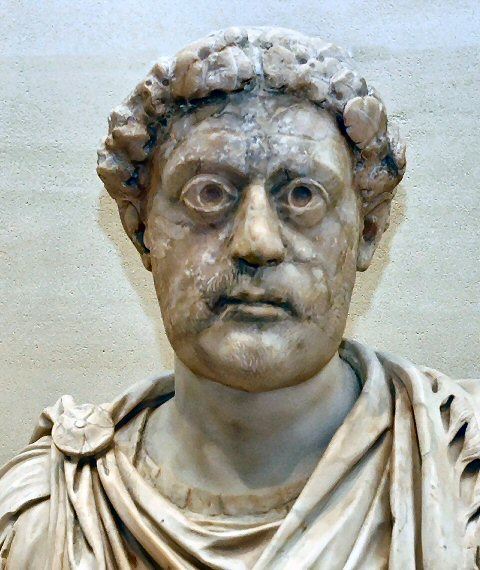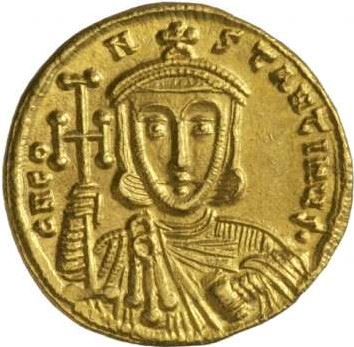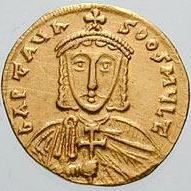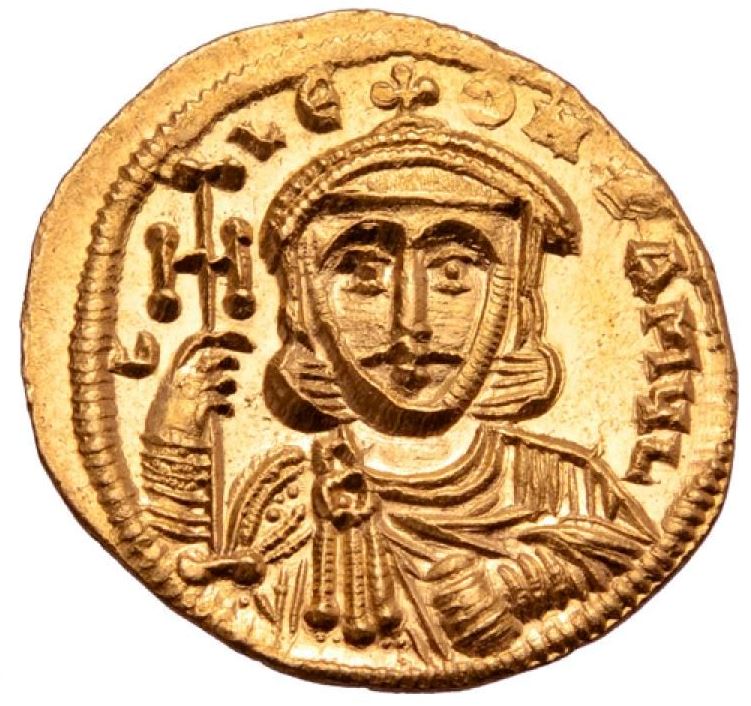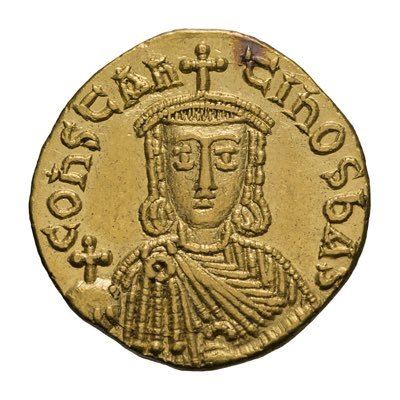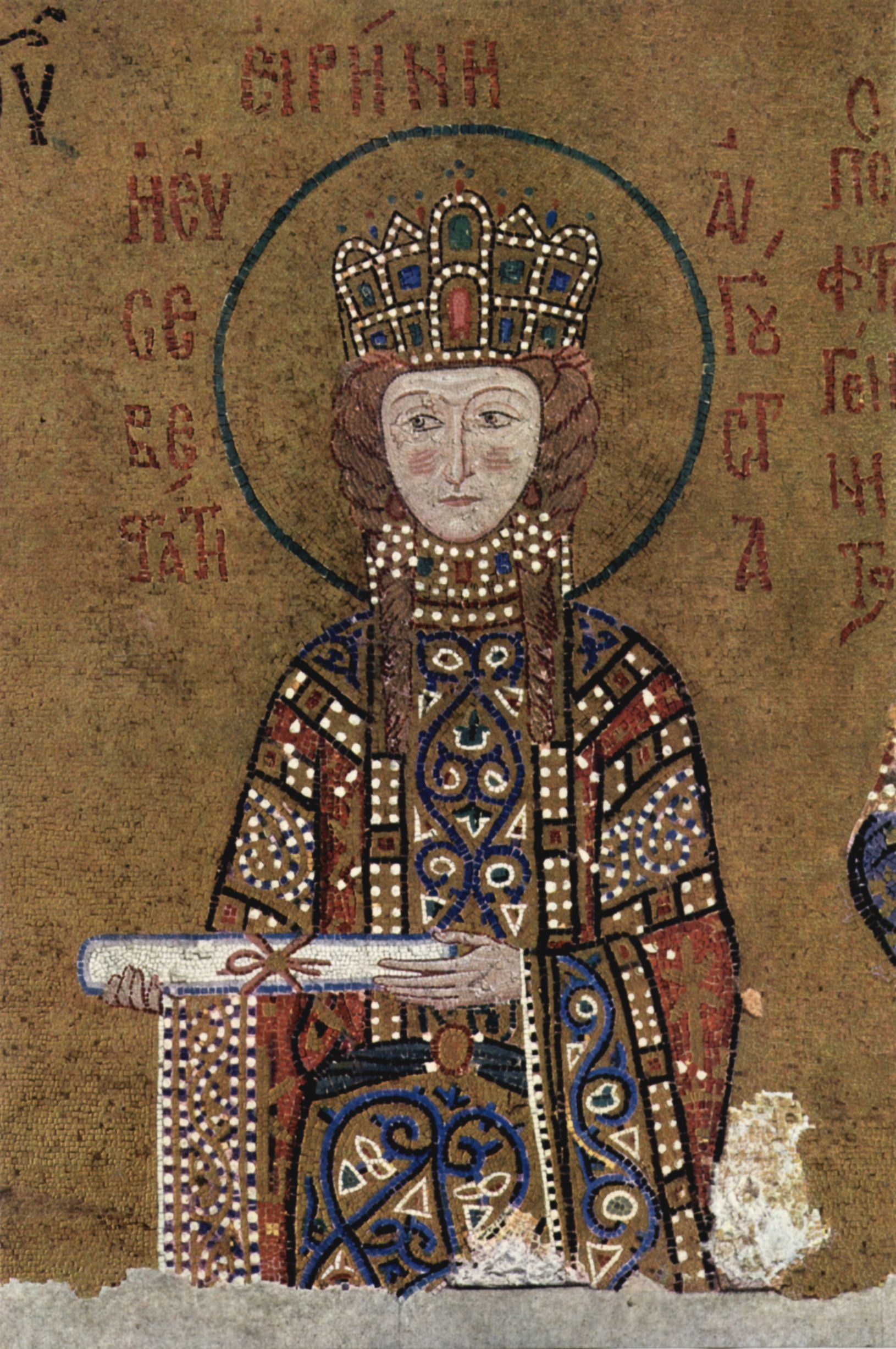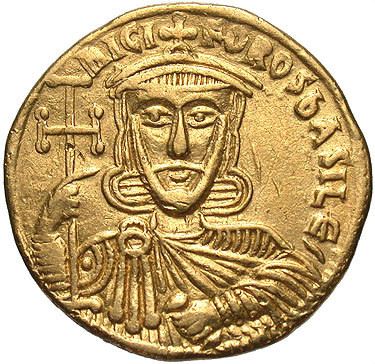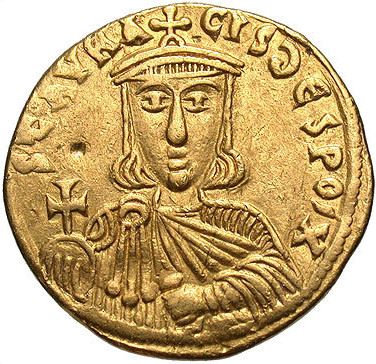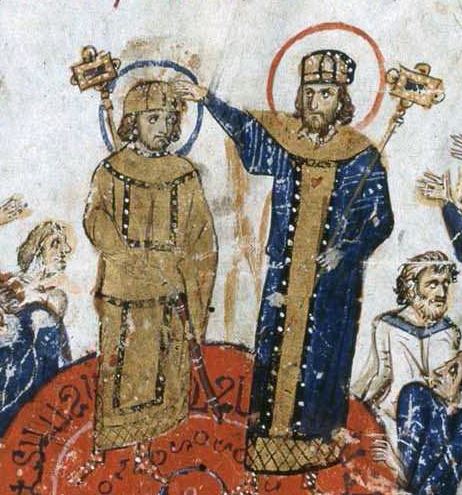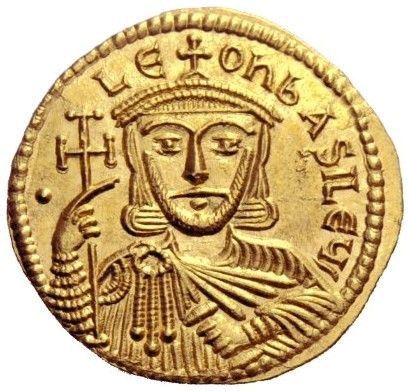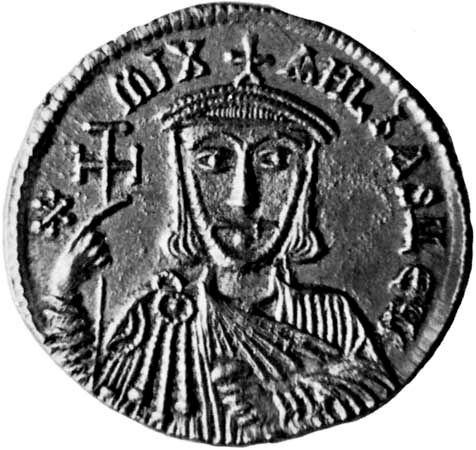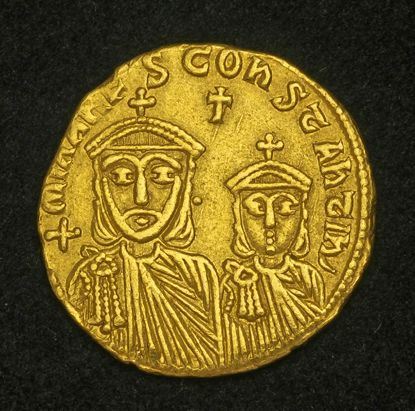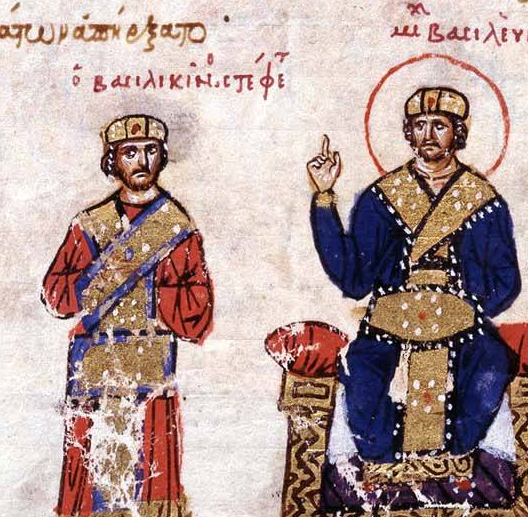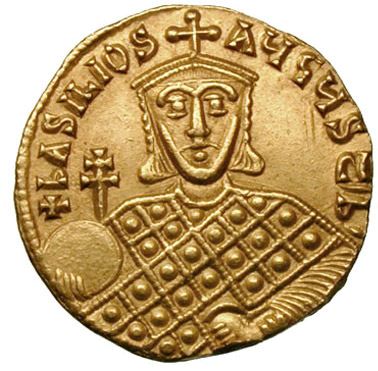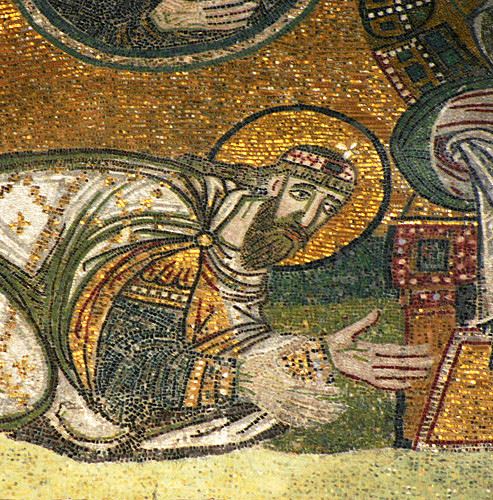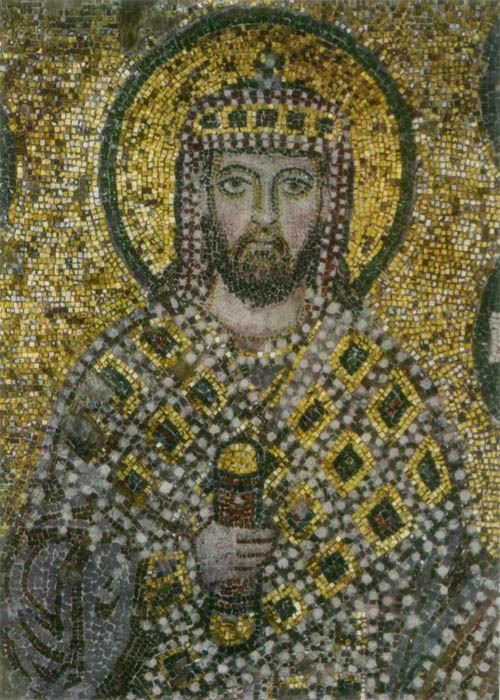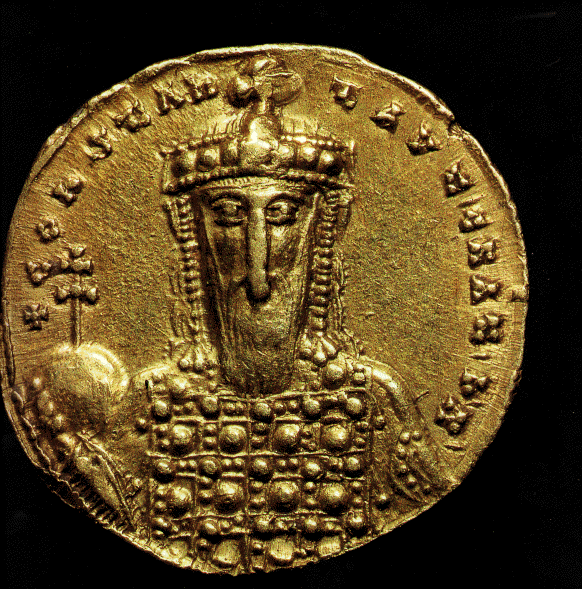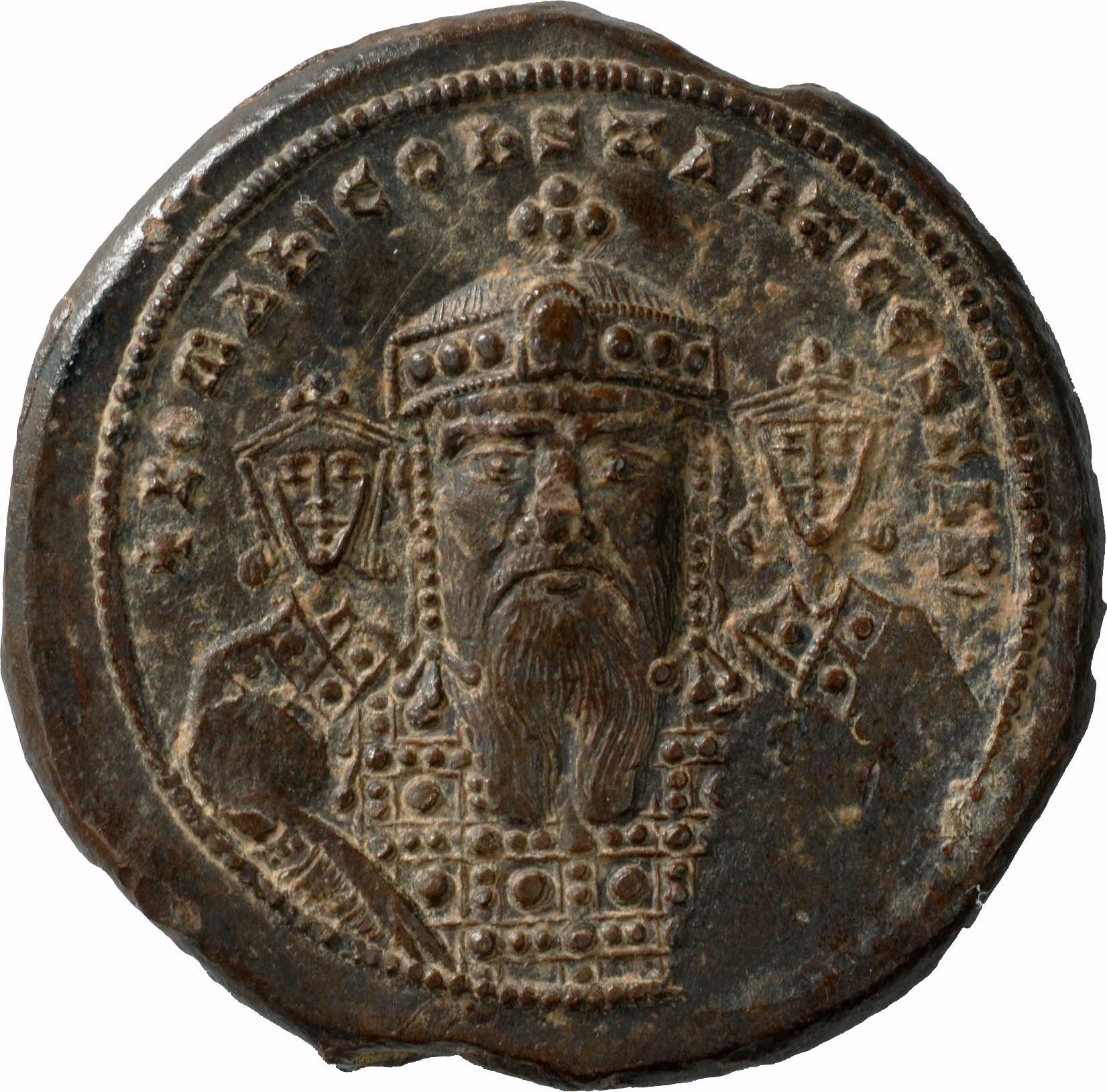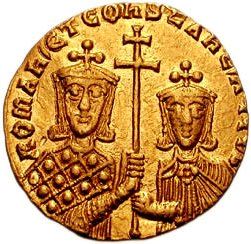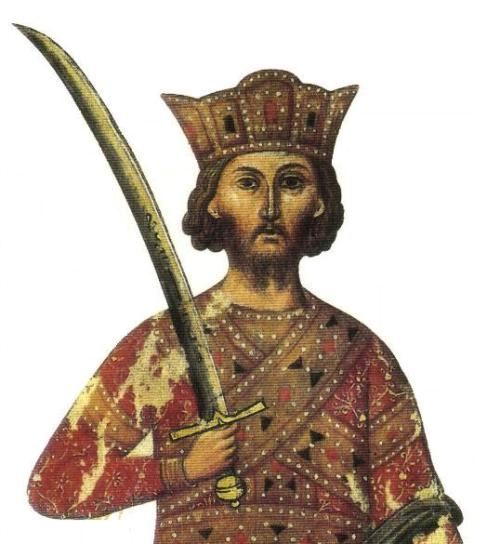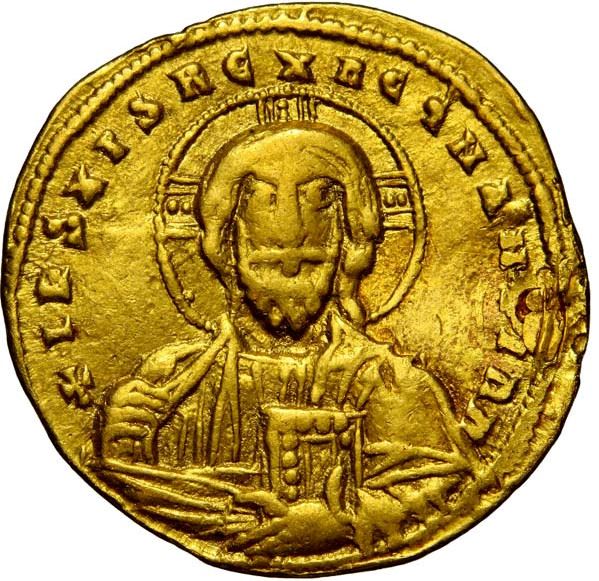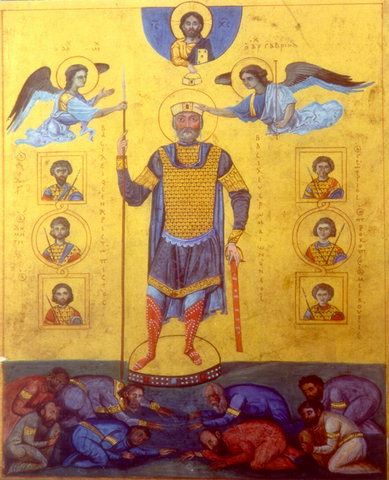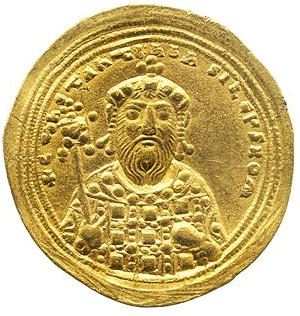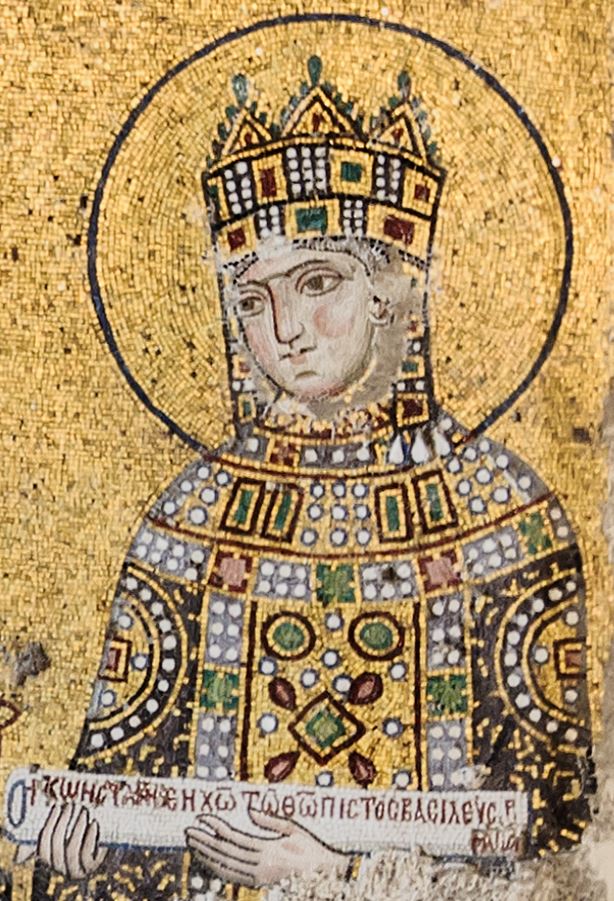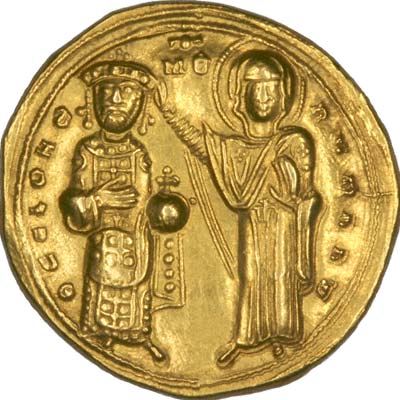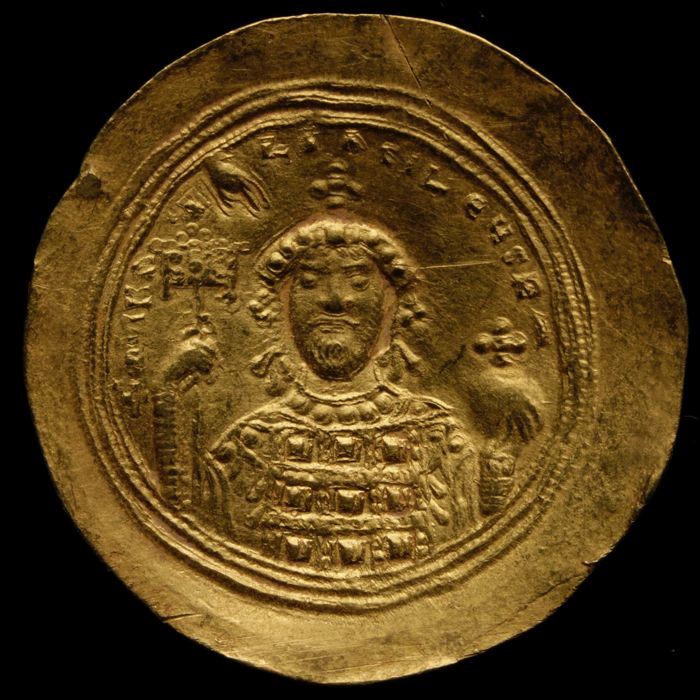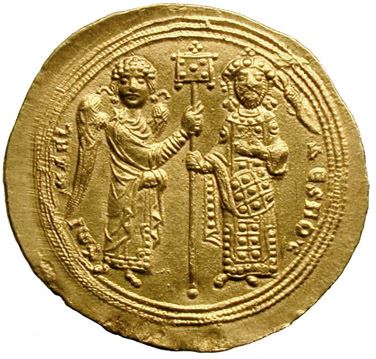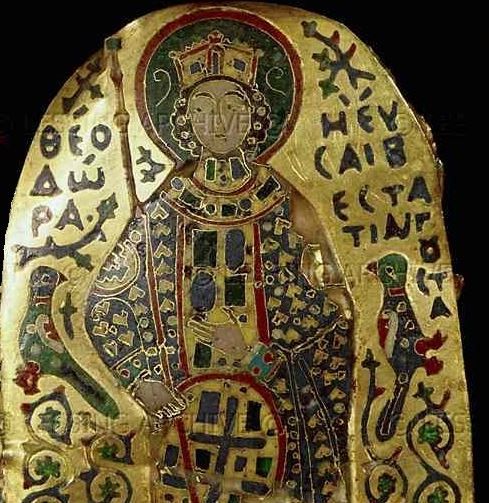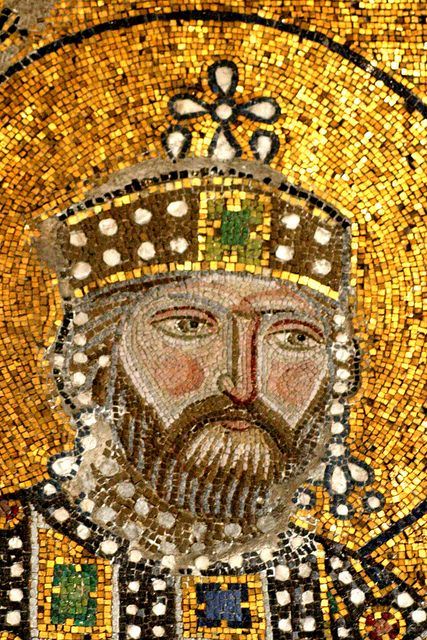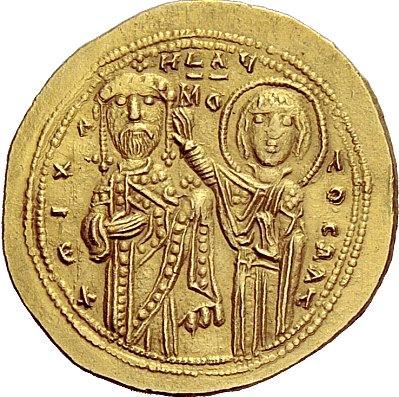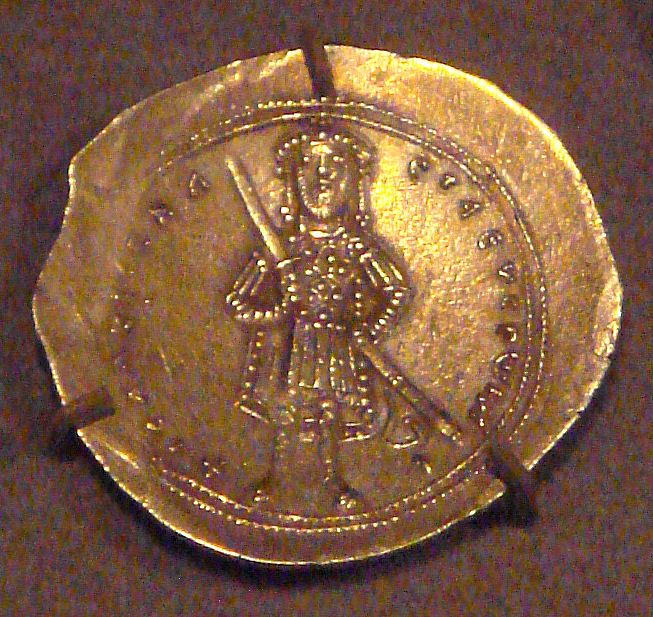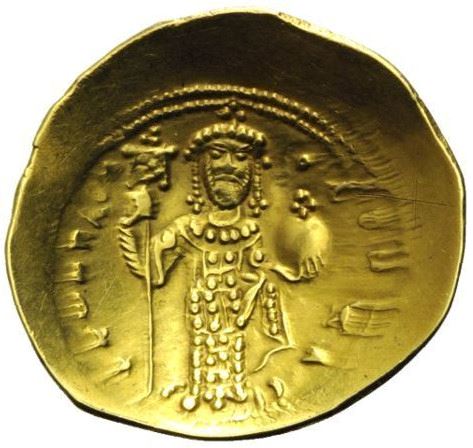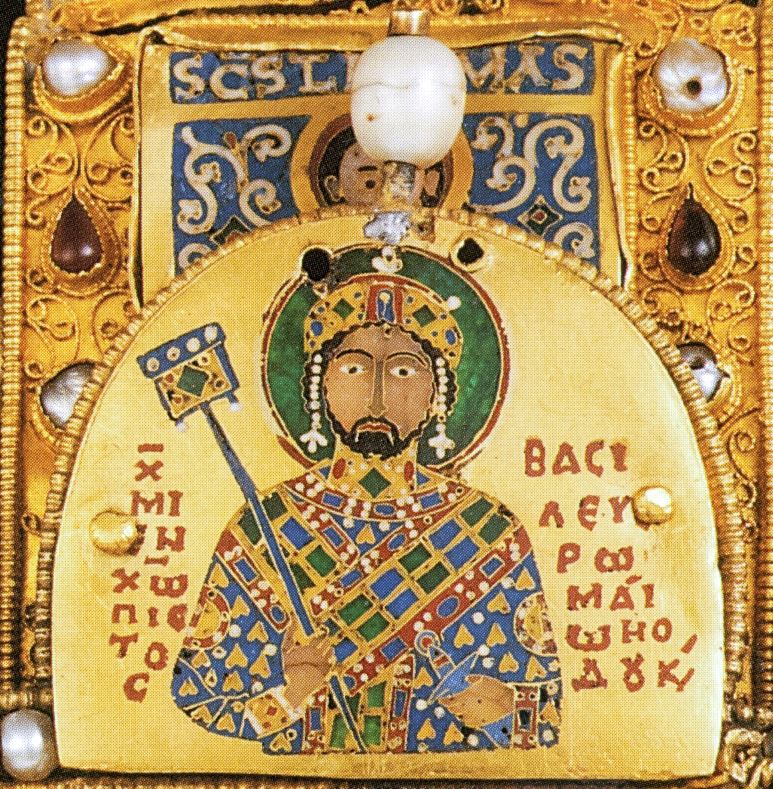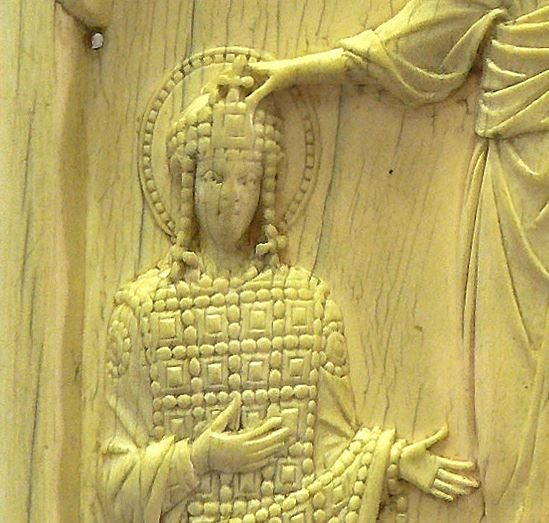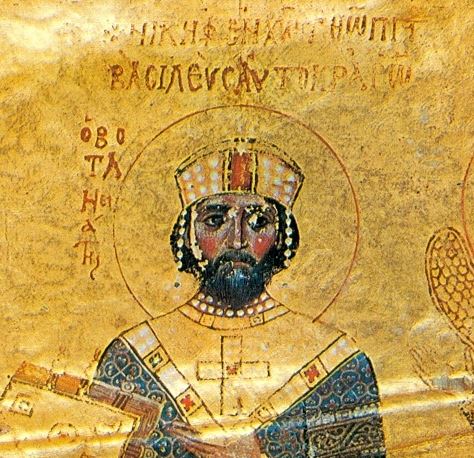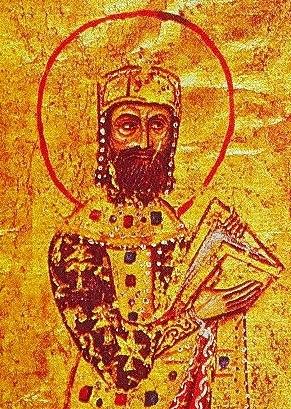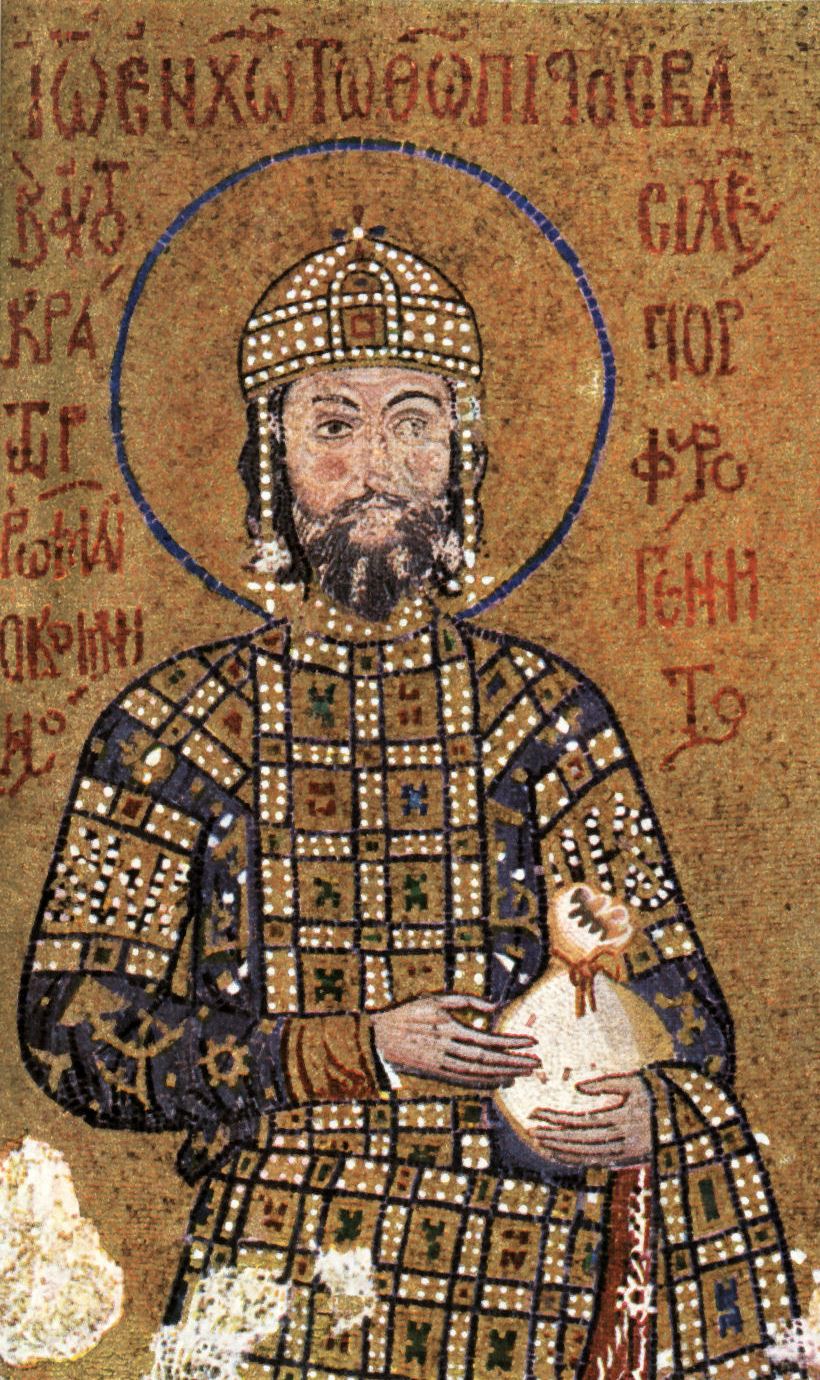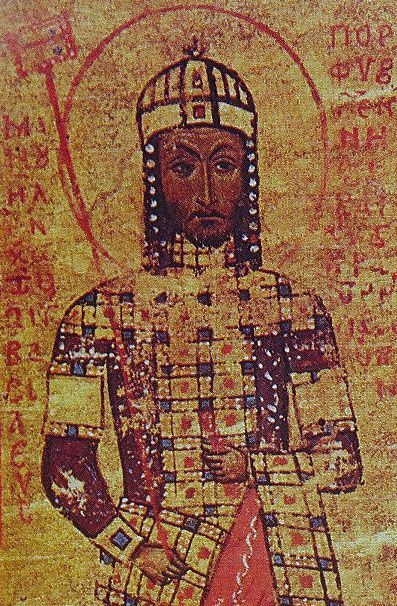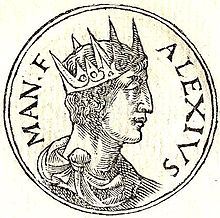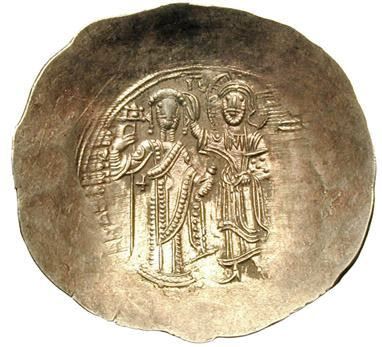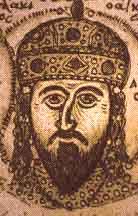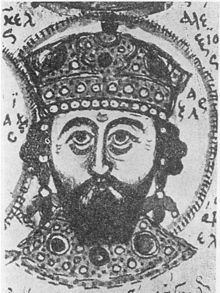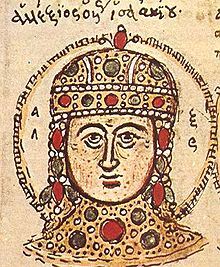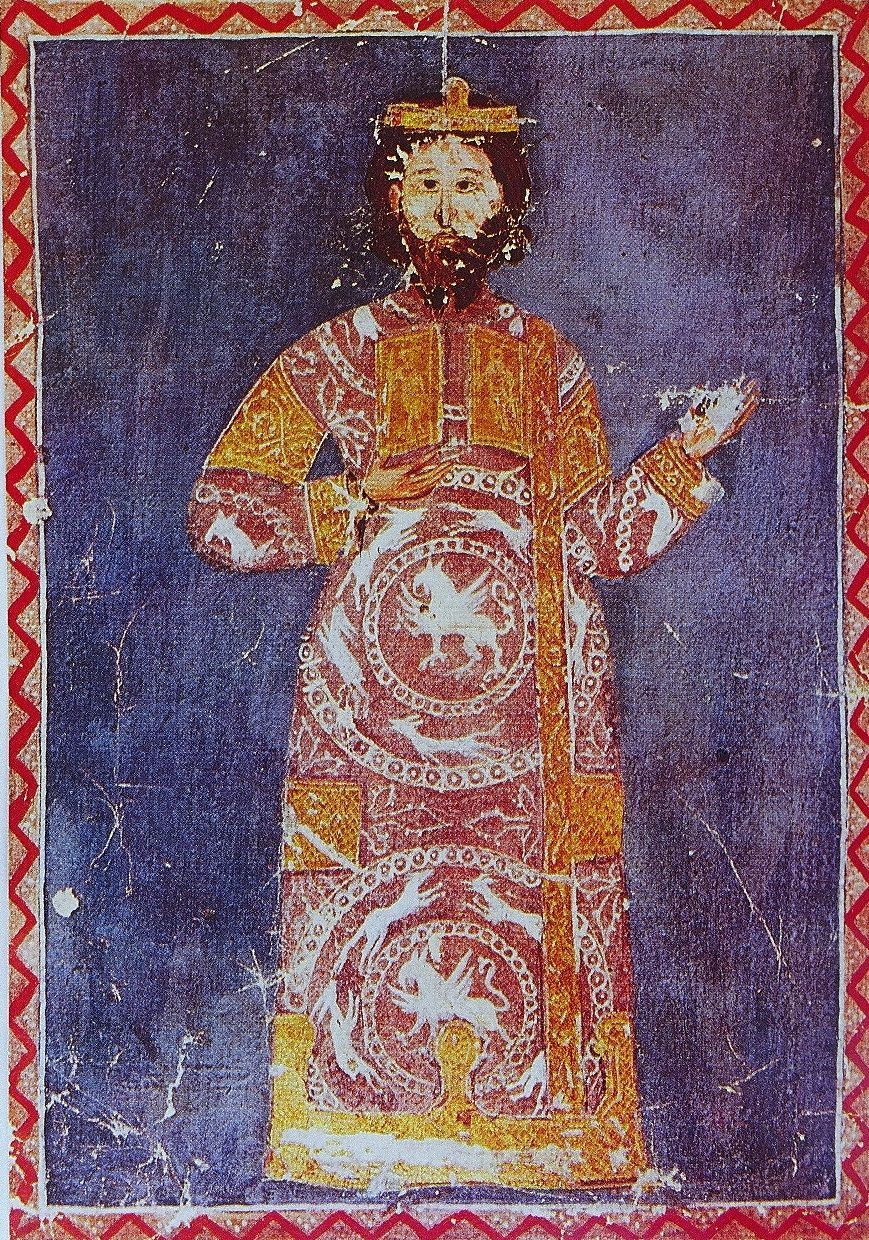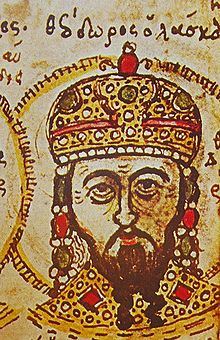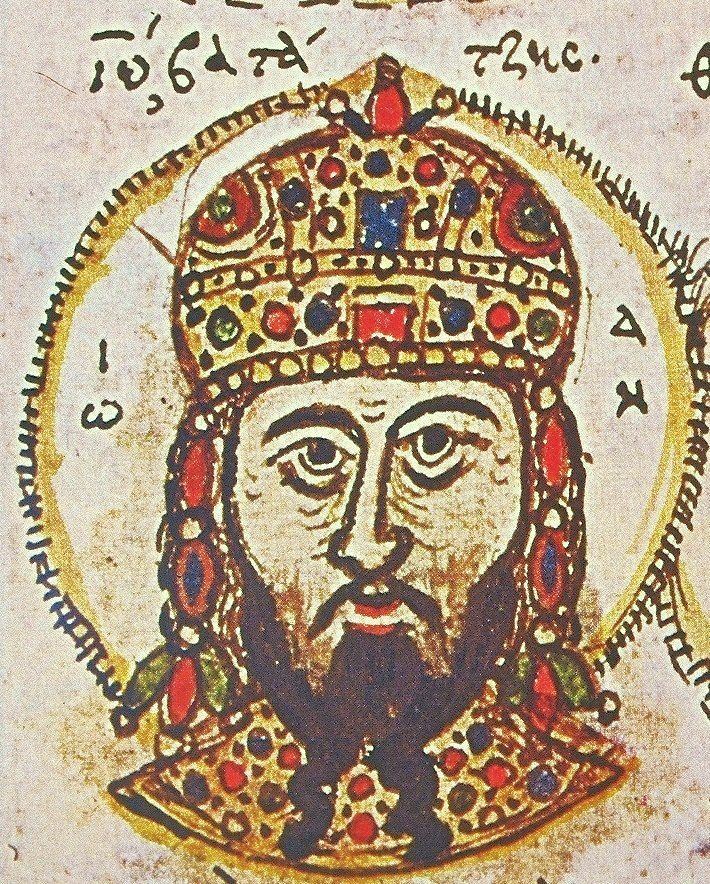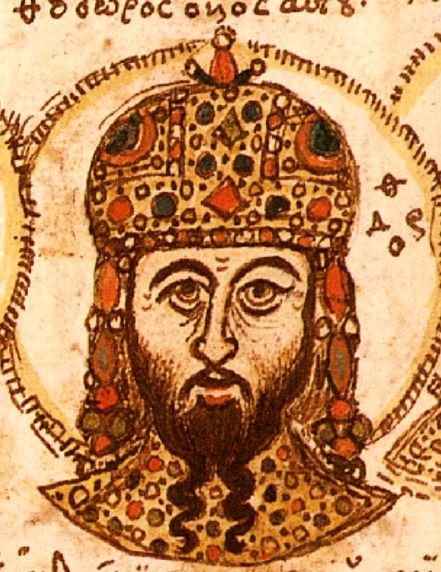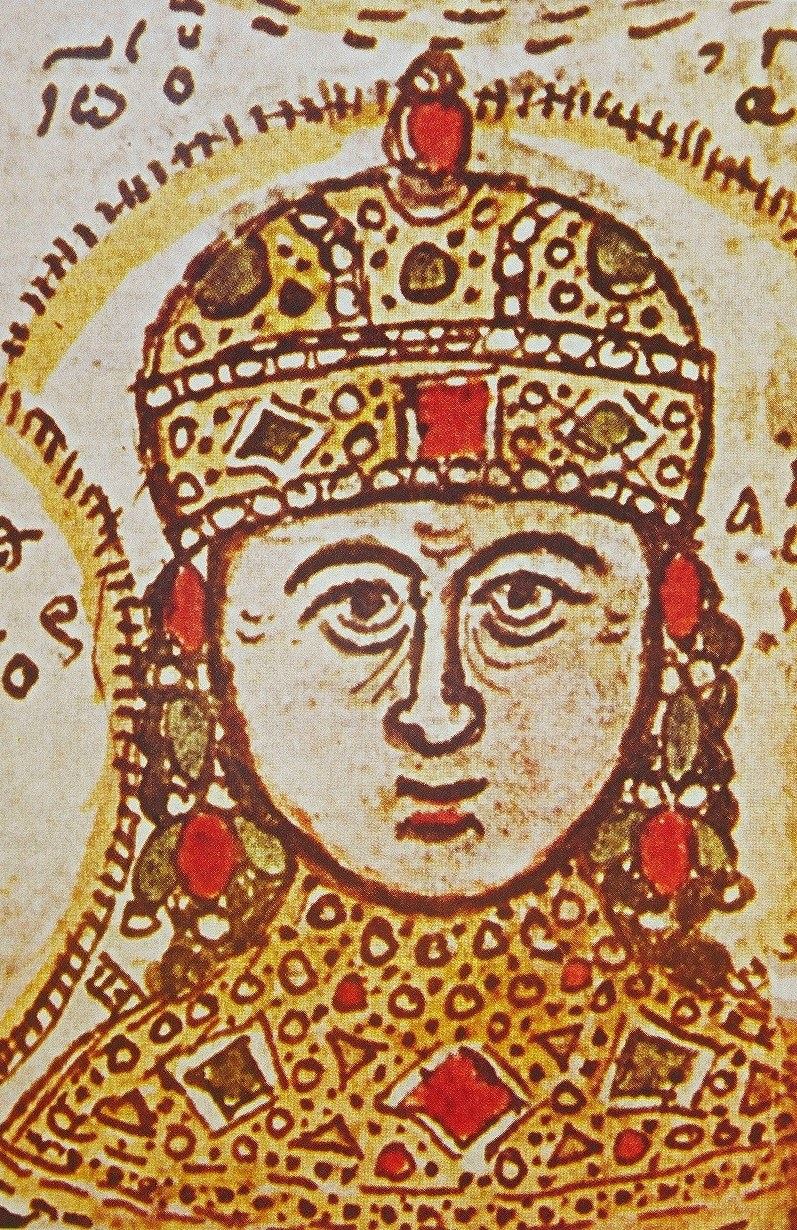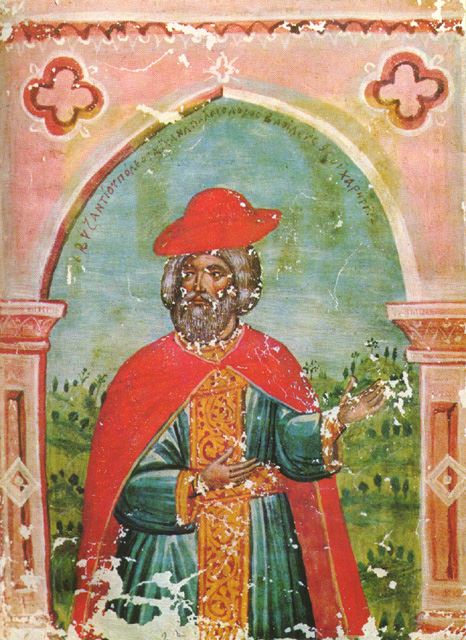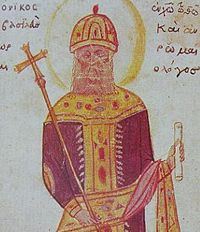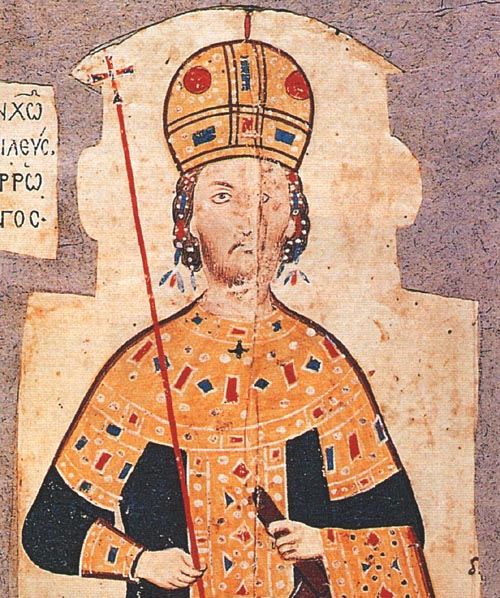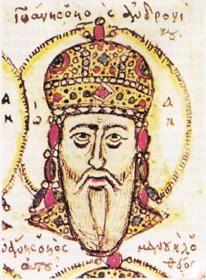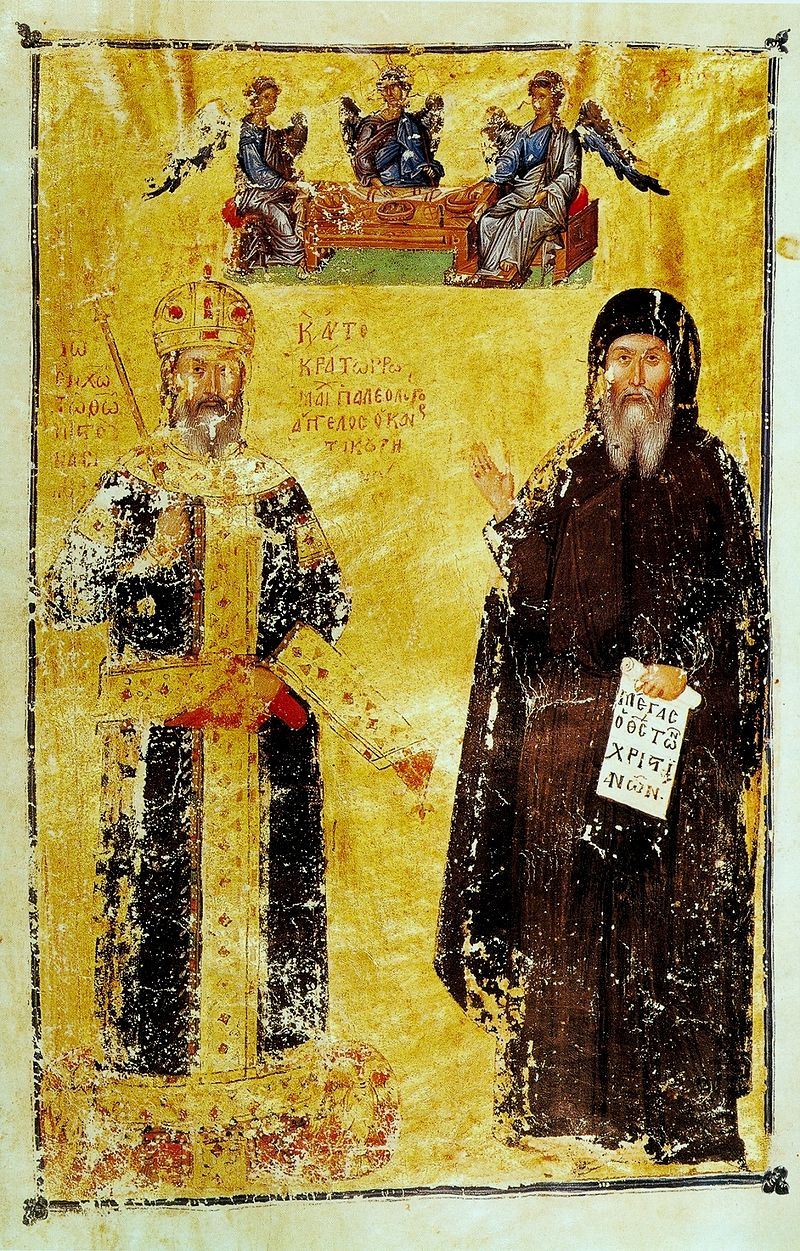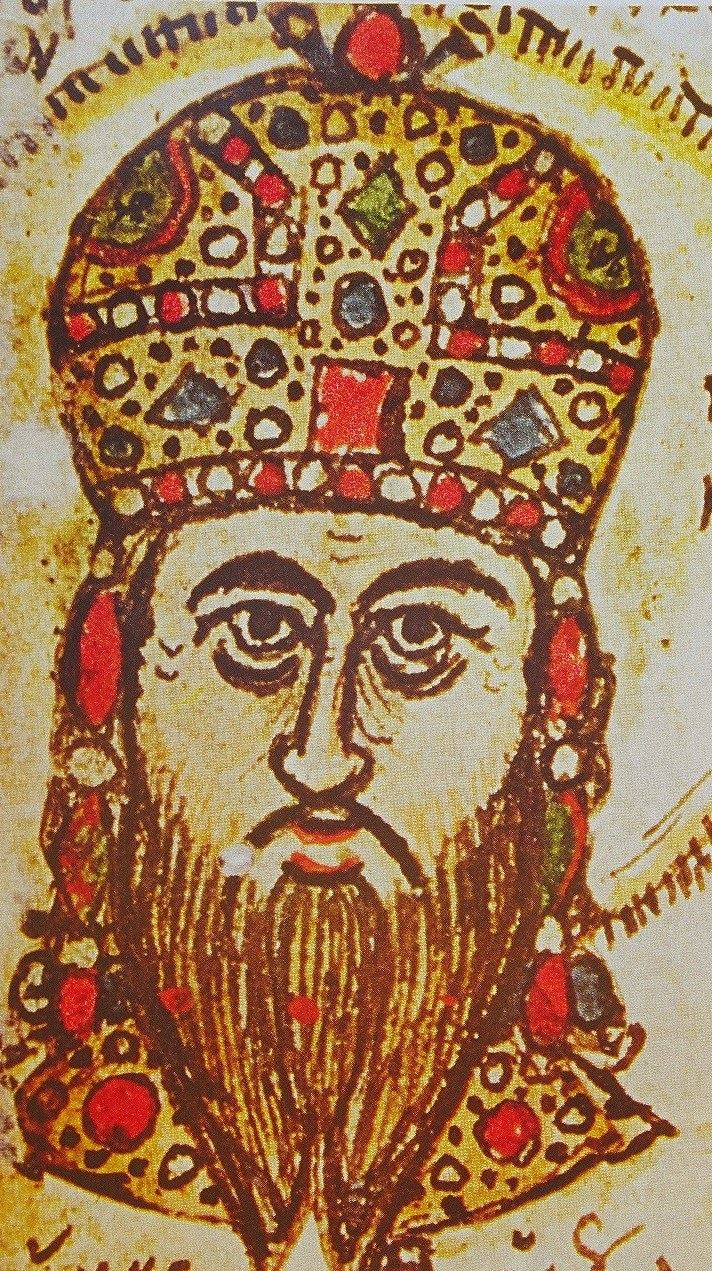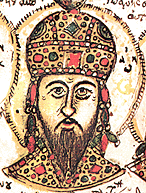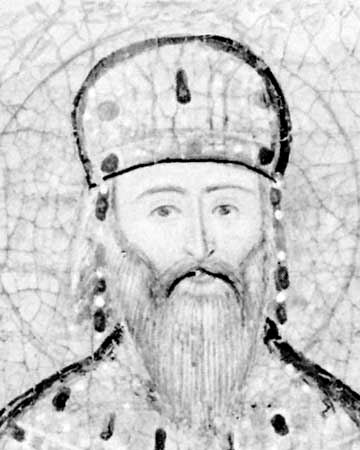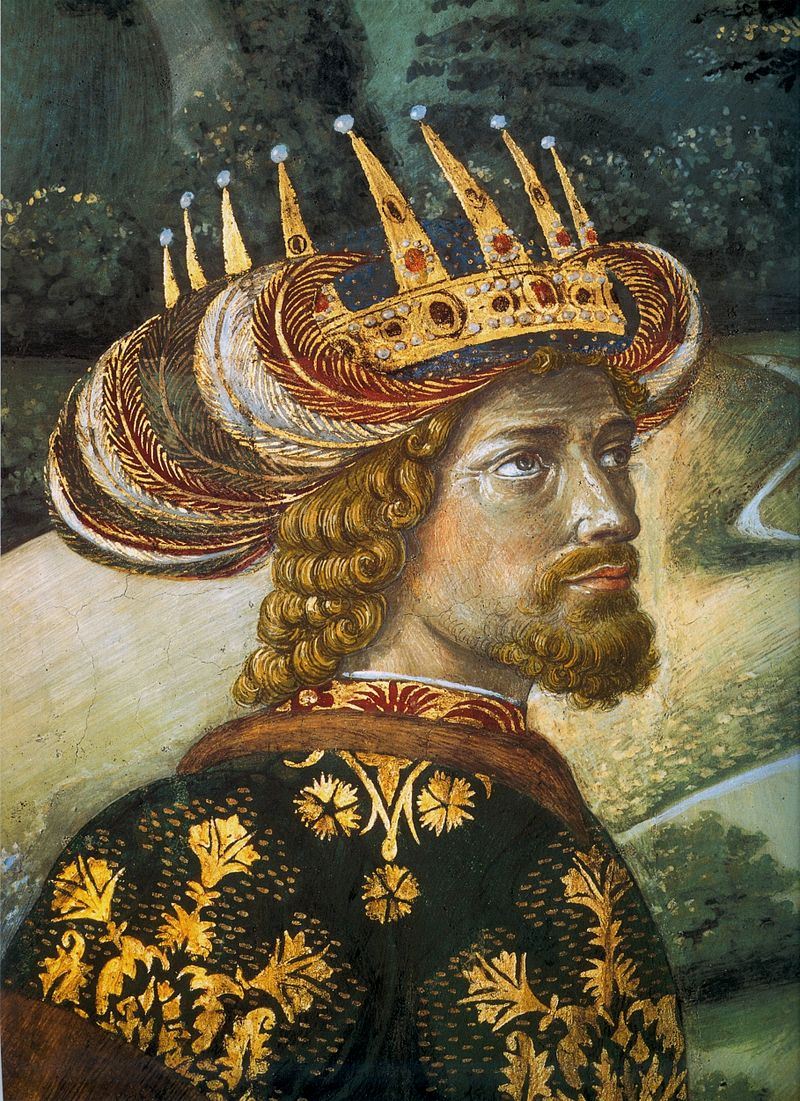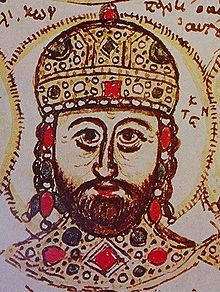Byzantine currency consisted of mainly two types of coins: the gold solidus and a variety of clearly valued bronze coins. This category covers coins struck for the East Roman Empire from Justinian I and until the fall of Constantinople in 1453.
Early Byzantine coins feature the head of the Emperor, now full face rather than in profile on the obverse, and usually a Christian symbol on the reverse.
In the 10th century, so-called "anonymous folles" were struck instead of the earlier coins depicting the emperor. The anonymous folles featured the bust of Jesus on the obverse and the inscription "XRISTUS/bASILEU/bASILE", which translates to "Christ, King of Kings".
Early Byzantine coins feature the head of the Emperor, now full face rather than in profile on the obverse, and usually a Christian symbol on the reverse.
In the 10th century, so-called "anonymous folles" were struck instead of the earlier coins depicting the emperor. The anonymous folles featured the bust of Jesus on the obverse and the inscription "XRISTUS/bASILEU/bASILE", which translates to "Christ, King of Kings".
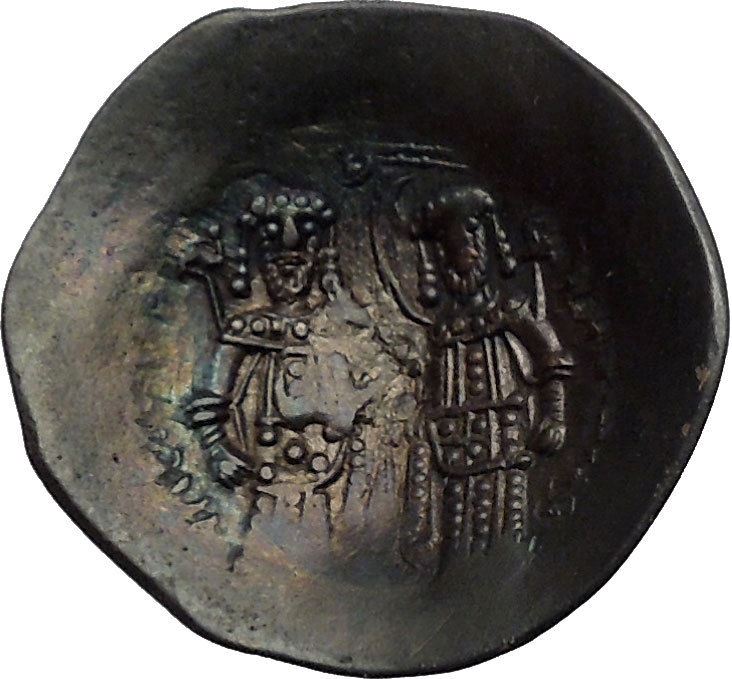
Anastasius I was Byzantine emperor from 491 to 518. He was born at Dyrrachium, into a noble Illyrian family, and rose to become a very successful financial administrator under several emperors.
Following the death of Zeno in 491, there is strong evidence that many Roman citizens wanted both a Roman and an Orthodox Christian emperor. In the weeks following Zeno's death, crowds gathered i...
Following the death of Zeno in 491, there is strong evidence that many Roman citizens wanted both a Roman and an Orthodox Christian emperor. In the weeks following Zeno's death, crowds gathered i...
The Ostrogoths were the eastern branch of the Germanic people called the Goths. They traced their origins to the Greutungi – a branch of the Goths who had migrated southward from the Baltic Sea and established a kingdom north of the Black Sea, during the 3rd and 4th centuries.
They were subjugated by the Huns in 370 AD, and little is heard of the Ostrogoths for about 80 years, after wh...
They were subjugated by the Huns in 370 AD, and little is heard of the Ostrogoths for about 80 years, after wh...
Flavius Iustinus Augustus was Byzantine emperor from 518 to 527. He rose through the ranks of the army and ultimately became Emperor, in spite of the fact he was illiterate and almost 70 years old at the time of accession.
His reign is noteworthy for the resolution of the Acacian Schism between the eastern and western branches of the Christian church. This temporary eastern deferral to ...
His reign is noteworthy for the resolution of the Acacian Schism between the eastern and western branches of the Christian church. This temporary eastern deferral to ...
The Vandals were a large East Germanic tribe or group of tribes which migrated from southern Scandinavia and settled in Silesia from around 120 BC. Expanding into Dacia during the Marcomannic Wars and to Pannonia during the Crisis of the Third Century, the Vandals were confined to Pannonia by the Goths around 330 AD, where they received permission to settle from Constantine the Great. Around 400, ...
Flavius Petrus Sabbatius Iustinianus Augustus - traditionally known as Justinian the Great - was Byzantine emperor from 527 to 565. His reign was marked by the ambitious but only partly realized renovatio imperii, or "restoration of the Empire".
A still more resonant aspect of his legacy was the uniform rewriting of Roman law, the Corpus Juris Civilis, which is still the basis of...
A still more resonant aspect of his legacy was the uniform rewriting of Roman law, the Corpus Juris Civilis, which is still the basis of...
Flavius Iustinus Iunior Augustus was Byzantine emperor from 565 to 574. He was the husband of Sophia, nephew of Justinian I and the Empress Theodora, and was therefore a member of the Justinian Dynasty.
Justin II's reign was marked by war with the Sassanid Empire and the loss of the greater part of Italy. Proud of character, and faced with an empty treasury, he discontinued Justinian's...
Justin II's reign was marked by war with the Sassanid Empire and the loss of the greater part of Italy. Proud of character, and faced with an empty treasury, he discontinued Justinian's...
Flavius Tiberius Constantinus Augustus was Byzantine emperor from 574 to 582. He was close friends with his predecessor Justin II, and was eventually adopted by him as his son and heir.
On 26 September 578, Tiberius was made Augustus by the rapidly-failing Justin. He used that opportunity to give away 7,200 pounds of gold, a practice that he continued annually throughout the four years ...
On 26 September 578, Tiberius was made Augustus by the rapidly-failing Justin. He used that opportunity to give away 7,200 pounds of gold, a practice that he continued annually throughout the four years ...
Flavius Mauricius Tiberius Augustus was Byzantine Emperor from 582 to 602. He was the son-in-law of his predecessor, Tiberius II.
His reign was troubled by financial difficulties and almost constant warfare; while he ended the war with Sasanian Persia with a victory and the cessation of two centuries of tribute, he fought extensively in the Balkans against the Avars and in Italy against...
His reign was troubled by financial difficulties and almost constant warfare; while he ended the war with Sasanian Persia with a victory and the cessation of two centuries of tribute, he fought extensively in the Balkans against the Avars and in Italy against...
Flavius Phocas Augustus was Byzantine Emperor from 602 to 610. The early life of Phocas is largely unknown, however he rose to prominence in 602, as a leader in the revolt against Emperor Maurice. He captured Constantinople and overthrew Maurice on 23 November 602, and declared himself as Byzantine Emperor on the same day.
Phocas deeply distrusted the elite of Constantinople, and there...
Phocas deeply distrusted the elite of Constantinople, and there...
Flavius Heracles Augustus was Byzantine emperor from 610 to 641. His rise to power began in 608, when he and his father, Heraclius the Elder, the viceroy of Africa, led a revolt against the unpopular usurper Phocas.
Heraclius's reign was marked by several military campaigns. He fought the Sasanid Empire from his ascension in 610, and avoided total defeat before driving the Persians from...
Heraclius's reign was marked by several military campaigns. He fought the Sasanid Empire from his ascension in 610, and avoided total defeat before driving the Persians from...
Constantine III was Byzantine emperor for 3 months in 641, making him the shortest reigning Byzantine emperor. He was the eldest son of the Byzantine Emperor Heraclius and his first wife Eudokia.
Constantine became senior Emperor when his father died in 641. He reigned together with his younger half-brother Heraklonas, the son of Martina. His supporters feared action against him on the ...
Constantine became senior Emperor when his father died in 641. He reigned together with his younger half-brother Heraklonas, the son of Martina. His supporters feared action against him on the ...
Heraklonas was Byzantine emperor for a short time in 641, following the death of his father Heraclius. He ruled jointly with his half-brother, Constantine III.
After Constantine died of tuberculosis in April/May 641, Heraklonas became sole emperor, under the regency of his mother due to his young age, usually dated from April/May – September/October 641, when he was overthrown by Valen...
After Constantine died of tuberculosis in April/May 641, Heraklonas became sole emperor, under the regency of his mother due to his young age, usually dated from April/May – September/October 641, when he was overthrown by Valen...
Constans II was emperor of the Byzantine Empire from 641 to 668. He was the last emperor to serve as consul, in 642. Constans is a diminutive nickname given to the Emperor, who had been baptized Herakleios and reigned officially as Constantine. The nickname established itself in Byzantine texts and has become standard in modern historiography.
Under Constans, the Byzantines completely w...
Under Constans, the Byzantines completely w...
Constantine IV was Byzantine Emperor from 668 to 685. His reign saw the first serious check to nearly 50 years of uninterrupted Islamic expansion.
After his father's assassination, the new emperor immediately faced a war with Caliph Muawiyah I. Chalcedon was conquered, then Carthage and Sicily in 669. Cyzicus in 670, and Smyrna and other coastal cities in 672, before sending a large fl...
After his father's assassination, the new emperor immediately faced a war with Caliph Muawiyah I. Chalcedon was conquered, then Carthage and Sicily in 669. Cyzicus in 670, and Smyrna and other coastal cities in 672, before sending a large fl...
Justinian II was the last Byzantine Emperor of the Heraclian Dynasty, reigning from 685 to 695 and again from 705 to 711. He was an ambitious and passionate ruler who was keen to restore the Roman Empire to its former glories, but he responded poorly to any opposition to his will and lacked the finesse of his father, Constantine IV.
Consequently, he generated enormous opposition to his ...
Consequently, he generated enormous opposition to his ...
Leontios was Byzantine emperor from 695 to 698. Little is known of his early life, other than that he was born in Isauria.
He was given the title of patrikios, and made Strategos of the Anatolic Theme under Emperor Justinian II. He led forces against the Umayyads during the early years of Justinian's reign, securing victory and forcing the Umayyad caliph to sue for peace.
In ...
He was given the title of patrikios, and made Strategos of the Anatolic Theme under Emperor Justinian II. He led forces against the Umayyads during the early years of Justinian's reign, securing victory and forcing the Umayyad caliph to sue for peace.
In ...
Tiberios III was Byzantine emperor from 698 to 21 August 705. Although his rule was considered generally successful, especially in containing the Arab threat to the east, he was overthrown by the former emperor Justinian II and subsequently executed.
Tiberius was a Germanic naval officer from the region of Pamphylia and originally named Apsimar. He participated in the failed campaign to...
Tiberius was a Germanic naval officer from the region of Pamphylia and originally named Apsimar. He participated in the failed campaign to...
Philippikos was Emperor of the Byzantine Empire from 711 to 713. Philippicus was originally named Bardanes, and is often referred to as Philippikos Bardanes.
Philippikos seized power when he successfully incited the Khazars to besiege Constantinople in opposition to Justinian II, who had returned to the throne no less harsh than he had left if when he was first ousted by Tiberios III. ...
Philippikos seized power when he successfully incited the Khazars to besiege Constantinople in opposition to Justinian II, who had returned to the throne no less harsh than he had left if when he was first ousted by Tiberios III. ...
Anastasios II was the Byzantine Emperor from 713 to 715. He was originally named Artemius (Ἀρτέμιος) and had served as a bureaucrat and Imperial secretary (asekretis) for his predecessors. After the Opsician army in Thrace had overthrown Emperor Philippikos Bardanes, they acclaimed Artemius as Emperor.
Soon after his accession, Anastasius II imposed discipline on the army and executed t...
Soon after his accession, Anastasius II imposed discipline on the army and executed t...
Theodosios III was Byzantine Emperor from 715 to 25 March 717. He was a financial officer and tax collector in the southern portion of the theme of Opsikion, before he was chosen as emperor by rebellious troops.
He did not readily accept this choice and, according to the chronicler Theophanes the Confessor, even attempted to hide in the forests near Adramyttium. Eventually he was found ...
He did not readily accept this choice and, according to the chronicler Theophanes the Confessor, even attempted to hide in the forests near Adramyttium. Eventually he was found ...
Leo III was Byzantine Emperor from 717 until his death in 741. He put an end to the Twenty Years' Anarchy, a period of great instability in the Byzantine Empire between 695 and 717, marked by the rapid succession of several emperors to the throne.
Leo, whose original name was Konon, was born in Germanikeia in the Syrian province of Commagene. He was appointed commander (stratēgos) of th...
Leo, whose original name was Konon, was born in Germanikeia in the Syrian province of Commagene. He was appointed commander (stratēgos) of th...
Constantine V was Byzantine emperor from 741 to 775. He was the son of his predecessor, Leo II.
Constantine V continued his father's iconoclast policies, and in 754 convened a synod in Hieria. The council approved of Constantine's religious policy and secured the election of a new Iconoclast patriarch, but refused to follow in all of Constantine's views. Nevertheless, the synod was foll...
Constantine V continued his father's iconoclast policies, and in 754 convened a synod in Hieria. The council approved of Constantine's religious policy and secured the election of a new Iconoclast patriarch, but refused to follow in all of Constantine's views. Nevertheless, the synod was foll...
Artabasdos was a Byzantine general of Armenian descent who seized the throne from June 741 or 742 until November 743. His reign constitutes a usurpation against Constantine V, who had retained control of several themes in Asia Minor.
Artabasdos abandoned his predecessor's religious policy of Iconoclasm and restored Orthodoxy with some support, including that of Pope Zacharias. Soon afte...
Artabasdos abandoned his predecessor's religious policy of Iconoclasm and restored Orthodoxy with some support, including that of Pope Zacharias. Soon afte...
Leo IV was Byzantine Emperor from 775 to 780 AD. He was born to Emperor Constantine V and Empress Tzitzak in 750. He was elevated to caesar the next year, in 751. When Constantine V died in September 775, while campaigning against the Bulgarians, Leo IV became senior emperor on 14 September 775.
Leo was by this point suffering from tuberculosis, which, combined with the infancy of his ...
Leo was by this point suffering from tuberculosis, which, combined with the infancy of his ...
Constantine VI was Byzantine Emperor from 780 to 797. The only child of Emperor Leo IV, Constantine was named co-emperor with him at the age of five in 776 and succeeded him as sole Emperor in 780, aged nine. His mother Irene exercised control over him as regent until 790, assisted by her chief minister Staurakios.
Though the regency lost power when Constantine reached maturity in 790, ...
Though the regency lost power when Constantine reached maturity in 790, ...
Irene was Byzantine empress consort by marriage to Leo IV from 775 to 780, Byzantine regent during the minority of her son Constantine VI from 780 until 790, and finally ruling Byzantine (Eastern Roman) empress from 797 to 802. She is best known for ending Iconoclasm.
Although it is often asserted that, as monarch, Irene called herself "basileus" (βασιλεύς), 'emperor', rather than "basi...
Although it is often asserted that, as monarch, Irene called herself "basileus" (βασιλεύς), 'emperor', rather than "basi...
Nikephoros I was Byzantine Emperor from 802 to 811, when he was killed in the Battle of Pliska. He is sometimes called "the Logothete" due to his previous position as Minister of Finance (Genikos Logothetes).
Nikephoros embarked on a general reorganization of the Roman Empire, creating new themes in the Balkans and strengthening the frontiers. Needing large sums to increase his military...
Nikephoros embarked on a general reorganization of the Roman Empire, creating new themes in the Balkans and strengthening the frontiers. Needing large sums to increase his military...
Staurakios was Byzantine Emperor from 26 July to 2 October 811. He was born some time after 778 AD, to Nikephoros I and an unknown woman. Nikephoros seized the throne of the Byzantine Empire from Irene of Athens in 802, and elevated Staurakios to co-emperor in December 803.
After Nikephoros fell in the Battle of Pliska on 26 July 811, Staurakios was declared emperor, despite his severe ...
After Nikephoros fell in the Battle of Pliska on 26 July 811, Staurakios was declared emperor, despite his severe ...
Michael I was Byzantine Emperor from 811 to 813. He was the son of the patrician Theophylact Rhangabe, the admiral of the Aegean fleet. He married Prokopia, the daughter of the future Emperor Nikephoros I, and received the high court dignity of kouropalatēs after his father-in-law's accession in 802.
Michael survived Nikephoros' disastrous campaign against Krum of Bulgaria, and was cons...
Michael survived Nikephoros' disastrous campaign against Krum of Bulgaria, and was cons...
Leo V was Emperor of the Byzantine Empire from 813 to 820. A senior general, he forced his predecessor, Michael I Rangabe, to abdicate and assumed the throne.
With the iconodule policy of his predecessors associated with defeats at the hands of Bulgarians and Arabs, Leo V reinstituted Iconoclasm after deposing patriarch Nikephoros and convoking a synod at Constantinople in 815. The Empe...
With the iconodule policy of his predecessors associated with defeats at the hands of Bulgarians and Arabs, Leo V reinstituted Iconoclasm after deposing patriarch Nikephoros and convoking a synod at Constantinople in 815. The Empe...
Michael II reigned as Byzantine Emperor from 25 December 820 to his death on 2 October 829, the first ruler of the Phrygian or Amorian dynasty.
Born in Amorium, Michael was a soldier, rising to high rank along with his colleague Leo V the Armenian. He helped Leo overthrow and take the place of Emperor Michael I Rangabe. However, after they fell out Leo sentenced Michael to death. Micha...
Born in Amorium, Michael was a soldier, rising to high rank along with his colleague Leo V the Armenian. He helped Leo overthrow and take the place of Emperor Michael I Rangabe. However, after they fell out Leo sentenced Michael to death. Micha...
Theophilos was the Byzantine Emperor from 829 until his death in 842. He was the second emperor of the Amorian dynasty and the last emperor to support iconoclasm.
Theophilos personally led the armies in his lifelong war against the Arabs, beginning in 831. In 837 Theophilos led a vast army of 70,000 men towards Mesopotamia and captured Melitene and Arsamosata. Theophilos returned to Con...
Theophilos personally led the armies in his lifelong war against the Arabs, beginning in 831. In 837 Theophilos led a vast army of 70,000 men towards Mesopotamia and captured Melitene and Arsamosata. Theophilos returned to Con...
Michael III was Byzantine Emperor from 842 to 867. HeI was the third and traditionally last member of the Amorian (or Phrygian) dynasty.
Michael was the youngest child of the emperor Theophilos and his empress Theodora. Already crowned co-ruler by his father in his infancy in 840, Michael had just turned two years old when his father died and Michael succeeded him as sole emperor on Jan...
Michael was the youngest child of the emperor Theophilos and his empress Theodora. Already crowned co-ruler by his father in his infancy in 840, Michael had just turned two years old when his father died and Michael succeeded him as sole emperor on Jan...
Basil I was a Byzantine Emperor who reigned from 867 to 886. Born a simple peasant in the theme of Macedonia, he rose in the Imperial court, and usurped the Imperial throne from Emperor Michael III.
Despite his humble origins, Basil showed great ability in running the affairs of state, leading to a revival of Imperial power and a renaissance of Byzantine art. It is remarkable that Basil...
Despite his humble origins, Basil showed great ability in running the affairs of state, leading to a revival of Imperial power and a renaissance of Byzantine art. It is remarkable that Basil...
Leo VI was Byzantine Emperor from 886 to 912. The second ruler of the Macedonian dynasty. He was very well-read, leading to his epithet; the Wise.
During his reign, the renaissance of letters, begun by his predecessor Basil I, continued; but the Empire also saw several military defeats in the Balkans against Bulgaria and against the Arabs in Sicily and the Aegean.
Leo VI cau...
During his reign, the renaissance of letters, begun by his predecessor Basil I, continued; but the Empire also saw several military defeats in the Balkans against Bulgaria and against the Arabs in Sicily and the Aegean.
Leo VI cau...
Alexandros or Alexander ruled as Emperor of the Byzantine Empire in 912–913. He was the third son of Emperor Basil I and Eudokia Ingerina, and the younger brother og Leo VI.
He was the first Byzantine emperor to use the term "autocrator" on coinage to celebrate the ending of his thirty-three years as co-emperor. Alexander promptly dismissed most of Leo's advisers and appointees, includi...
He was the first Byzantine emperor to use the term "autocrator" on coinage to celebrate the ending of his thirty-three years as co-emperor. Alexander promptly dismissed most of Leo's advisers and appointees, includi...
Constantine VII was the fourth Emperor of the Macedonian dynasty of the Byzantine Empire, reigning from 913 to 959. He was the son of the emperor Leo VI and his fourth wife, Zoe Karbonopsina, and the nephew of his predecessor, the emperor Alexander.
Most of his reign was dominated by co-regents: from 913 until 919 he was under the regency of his mother, while from 920 until 945 he share...
Most of his reign was dominated by co-regents: from 913 until 919 he was under the regency of his mother, while from 920 until 945 he share...
Romanos I was an Armenian who became a Byzantine naval commander and reigned as Byzantine Emperor from 920 until his deposition on December 16, 944. He ruled alongside his son in law, Constantine VII.
Romanos I Lekapenos attempted to strengthen the Byzantine Empire by seeking peace everywhere that it was possible. He was active as a legislator, promulgating a series of laws to protect s...
Romanos I Lekapenos attempted to strengthen the Byzantine Empire by seeking peace everywhere that it was possible. He was active as a legislator, promulgating a series of laws to protect s...
Romanos II was Byzantine Emperor from 959, when he succeeded his father Constantine VII, and until his sudden death in 963.
Romanos purged his father's courtiers of his enemies and replaced them with friends. To appease his bespelling wife, he excused his mother, Empress Helena, from court and forced his five sisters into convents. Nevertheless, many of Romanos' appointees were able men...
Romanos purged his father's courtiers of his enemies and replaced them with friends. To appease his bespelling wife, he excused his mother, Empress Helena, from court and forced his five sisters into convents. Nevertheless, many of Romanos' appointees were able men...
Nikephoros II was Byzantine Emperor from 963 to 969. His brilliant military exploits contributed to the resurgence of the Byzantine Empire during the 10th century.
Nikephoros' popularity was largely based on his conquests. Due to the resources he allocated to his army, Nikephoros was compelled to exercise a rigid economic policy in other departments. He retrenched court largess and curt...
Nikephoros' popularity was largely based on his conquests. Due to the resources he allocated to his army, Nikephoros was compelled to exercise a rigid economic policy in other departments. He retrenched court largess and curt...
John I was the senior Byzantine Emperor from 11 December 969 to 10 January 976. An intuitive and successful general, he strengthened the Empire and expanded its borders during his short reign.
Contemporary sources describe Tzimiskes as a rather short but well-built man, with reddish blonde hair and beard and blue eyes who was attractive to women. He seems to have joined the army at an e...
Contemporary sources describe Tzimiskes as a rather short but well-built man, with reddish blonde hair and beard and blue eyes who was attractive to women. He seems to have joined the army at an e...
Basil II was Byzantine Emperor from 10 January 976 to 15 December 1025. He was the second longest reigning emperor after his brother Constantine VIII whom he named co-emperor in 962, but outlived him by 3 years.
The early years of his long reign were dominated by civil war against powerful generals from the Anatolian aristocracy. Following their submission, Basil oversaw the stabilizat...
The early years of his long reign were dominated by civil war against powerful generals from the Anatolian aristocracy. Following their submission, Basil oversaw the stabilizat...
Constantine VIII was the Byzantine Emperor from 15 December 1025 until his death in 1028. He was the son of the Emperor Romanos II and Theophano and the younger brother of the eminent Basil II, who died childless and thus left the rule of the Byzantine Empire in his hands.
Basil died childless on 15 December 1025 and Constantine became sole emperor as Constantine VIII. He was sixty-five...
Basil died childless on 15 December 1025 and Constantine became sole emperor as Constantine VIII. He was sixty-five...
Zoe reigned as Byzantine Empress alongside her sister Theodora from April 19 to June 11, 1042. She was also enthroned as the empress consort to a series of co-rulers beginning with Romanos III in 1028 until her death in 1050 while married to Constantine IX.
Zoë was fifty when she first married, yet despite her age, she married twice more. Ironically, the most capable of her husbands was...
Zoë was fifty when she first married, yet despite her age, she married twice more. Ironically, the most capable of her husbands was...
Romanos III was Byzantine emperor from 15 November 1028 until his death in 1034. He was a Byzantine noble and senior official in Constantinople when, at the age of 60, he was forced to divorce his wife by Constantine VIII and marry the emperor's sister. Three days later the emperor died and Romanos inherited the throne.
The new emperor showed great eagerness to make his mark as a ruler,...
The new emperor showed great eagerness to make his mark as a ruler,...
Michael IV was Byzantine Emperor from 11 April 1034 to his death on 10 December 1041. He owed his elevation to his lover Empress Zoe, daughter of Emperor Constantine VIII and wife of Romanos III Argyros.
Michael IV was handsome, clever, and generous, but he was uneducated and suffered from epileptic fits. This meant he was initially very reliant upon someone to direct the government in ...
Michael IV was handsome, clever, and generous, but he was uneducated and suffered from epileptic fits. This meant he was initially very reliant upon someone to direct the government in ...
MIchael V was Byzantine emperor for four months in 1041–1042, the nephew and successor of Michael IV and the adoptive son of his wife, the Empress Zoe.
Determined to rule on his own, Michael V came into conflict with his uncle John the Orphanotrophos, whom he almost immediately banished to a monastery. Michael now reversed his uncle's decisions, recalling the nobles and courtiers who h...
Determined to rule on his own, Michael V came into conflict with his uncle John the Orphanotrophos, whom he almost immediately banished to a monastery. Michael now reversed his uncle's decisions, recalling the nobles and courtiers who h...
Theodora was a Byzantine Empress born into the Macedonian dynasty that had ruled the Byzantine Empire for almost two hundred years. She was co-empress with her sister Zoë for two months in 1042 and sole empress regnant from 11 January 1055 to 31 August 1056.
Theodora became gravely ill with an intestinal disorder in late August 1056 and died a few days later, on 31 August 1056, aged 75 ...
Theodora became gravely ill with an intestinal disorder in late August 1056 and died a few days later, on 31 August 1056, aged 75 ...
Constantine IX reigned as Byzantine emperor from June 11, 1042 to January 11, 1055. He had been chosen by the Empress Zoe as a husband and co-emperor in 1042, although he had been exiled for conspiring against her previous husband, Emperor Michael IV the Paphlagonian. They ruled together until Zoe died in 1050.
Constantine continued the purge instituted by Zoe and Theodora, removing the...
Constantine continued the purge instituted by Zoe and Theodora, removing the...
Michael VI reigned as Byzantine emperor from 1056 to 1057. Originally an elderly patrician and a member of the court bureaucracy who had served as military finance minister , Michael Bringas was chosen by the empress Theodora as her successor shortly before her death on August 31, 1056.
Although Michael managed to survive a conspiracy organized by Theodosios, a nephew of the former em...
Although Michael managed to survive a conspiracy organized by Theodosios, a nephew of the former em...
Isaac I was Byzantine Emperor from 1057 to 1059, the first reigning member of the Komnenos dynasty. During his brief reign he attempted to restore the depleted finances of the empire and the former strict organization of the government.
Isaac became emperor following a revolt against his predecessor, Michael VI. The first act of the new emperor was to reward his noble partisans with ap...
Isaac became emperor following a revolt against his predecessor, Michael VI. The first act of the new emperor was to reward his noble partisans with ap...
Constantine X was emperor of the Byzantine Empire from 24 November 1059 to 22 May 1067.
The new emperor quickly included two of his young sons with the throne, appointed his brother John Doukas as kaisar (Caesar), and embarked on a policy favorable to the interests of the court bureaucracy and the church. Severely undercutting the training and financial support for the armed forces, Con...
The new emperor quickly included two of his young sons with the throne, appointed his brother John Doukas as kaisar (Caesar), and embarked on a policy favorable to the interests of the court bureaucracy and the church. Severely undercutting the training and financial support for the armed forces, Con...
Michael VII was Byzantine emperor from 1071 to 1078. He was associated with his father on the throne late in 1059, together with or shortly before his newly born brother Konstantios Doukas.
When Constantine X died in 1067, Michael VII was 17 years old and should have been able to rule by himself. He exhibited little interest in politics, however, and his mother Eudokia and uncle John D...
When Constantine X died in 1067, Michael VII was 17 years old and should have been able to rule by himself. He exhibited little interest in politics, however, and his mother Eudokia and uncle John D...
Romanos IV was a member of the Byzantine military aristocracy who, after his marriage to the widowed empress Eudokia Makrembolitissa, was crowned Byzantine emperor and reigned from 1068 to 1071.
During his reign he was determined to halt the decline of the Byzantine military and to stop Turkish incursions into the Byzantine Empire. However, it was soon evident that while Romanos posses...
During his reign he was determined to halt the decline of the Byzantine military and to stop Turkish incursions into the Byzantine Empire. However, it was soon evident that while Romanos posses...
Nikephoros III was Byzantine emperor from 1078 to 1081. He was born in c. 1002, and became a general during the reign of Constantine X. He backed Isaac I Komnenos in his successful attempt to seize the throne, serving a prominent role during the Battle of Petroe. In 1078, he revolted against Emperor Michael VII, claiming the throne for himself, with the support of the Seljuk Turks.
Afte...
Afte...
Alexios I was Byzantine emperor from 1081 to 1118. Although he was not the founder of the Komnenian dynasty, it was during his reign that the Komnenos family came to full power. Inheriting a collapsing empire and faced with constant warfare during his reign against both the Seljuq Turks in Asia Minor and the Normans in the western Balkans, Alexios was able to curb the Byzantine decline and begin t...
John II was Byzantine Emperor from 1118 to 1143. Also known as "John the Beautiful" or "John the Good", he was the eldest son of Emperor Alexios I Komnenos and Irene Doukaina and the second emperor to rule during the Komnenian restoration of the Byzantine Empire.
John has been assessed as the greatest of the Komnenian emperors. In the course of his twenty-five year reign, he made allian...
John has been assessed as the greatest of the Komnenian emperors. In the course of his twenty-five year reign, he made allian...
Manuel I was Byzantine Emperor from 1143 to 1180, and reigned over a crucial turning point in the history of Byzantium and the Mediterranean. His reign saw the last flowering of the Komnenian restoration, during which the Byzantine Empire had seen a resurgence of its military and economic power, and had enjoyed a cultural revival.
Eager to restore his empire to its past glories as the ...
Eager to restore his empire to its past glories as the ...
Alexios II was Byzantine emperor from 1180 to 1183. He was the son of Emperor Manuel I Komnenos and Maria, daughter of Raymond of Poitiers, prince of Antioch.
On Manuel's death in 1180, Maria, who became a nun under the name Xene, took the position of regent She excluded her young son from power, entrusting it instead to Alexios the prōtosebastos (a cousin of Alexios II), who was popul...
On Manuel's death in 1180, Maria, who became a nun under the name Xene, took the position of regent She excluded her young son from power, entrusting it instead to Alexios the prōtosebastos (a cousin of Alexios II), who was popul...
Andronikos I was Byzantine Emperor from 1183 to 1185. He was the son of Isaac Komnenos and the grandson of the emperor Alexios I.
The reign of Andronikos was characterized by his harsh measures. He resolved to suppress many abuses but above all things to check feudalism and limit the power of the nobles, who were rivals for his throne. The people, who felt the severity of his laws, at t...
The reign of Andronikos was characterized by his harsh measures. He resolved to suppress many abuses but above all things to check feudalism and limit the power of the nobles, who were rivals for his throne. The people, who felt the severity of his laws, at t...
Isaac II was Byzantine Emperor from 1185 to 1195, and again from 1203 to 1204. While preparing for yet another offensive against Bulgaria in 1195, Alexios Angelos, the Emperor's older brother, taking advantage of Isaac's absence from camp on a hunting expedition, proclaimed himself emperor and was readily recognised by the soldiers as Emperor Alexios III. Isaac was blinded and imprisoned in Consta...
Alexios III was Byzantine Emperor from March 1195 to July 17/18, 1203. A member of the extended imperial family, Alexios came to throne after deposing, blinding, and imprisoning his younger brother Isaac II Angelos.
The most significant event of his reign was the attack of the Fourth Crusade on Constantinople in 1203, on behalf of Alexios IV Angelos. Alexios III took over the defense of...
The most significant event of his reign was the attack of the Fourth Crusade on Constantinople in 1203, on behalf of Alexios IV Angelos. Alexios III took over the defense of...
Alexios IV was Byzantine Emperor from August 1203 to January 1204. He was the son of Emperor Isaac II Angelus and his first wife, an unknown Palaiologina.
On 18 July 1203 the Crusaders launched an assault on the city, and Alexios III immediately fled into Thrace. The next morning the citizens had released Isaac II from prison and proclaimed him emperor. The Crusaders could not accept th...
On 18 July 1203 the Crusaders launched an assault on the city, and Alexios III immediately fled into Thrace. The next morning the citizens had released Isaac II from prison and proclaimed him emperor. The Crusaders could not accept th...
Alexios V was Byzantine emperor from 5 February to 12 April 1204 during the second and final siege of Constantinople by the participants of the Fourth Crusade.
He achieved power through a palace coup, killing his predecessors in the process. Though he made vigorous attempts to defend Constantinople from the crusader army, his military efforts proved ineffective. His actions won the supp...
He achieved power through a palace coup, killing his predecessors in the process. Though he made vigorous attempts to defend Constantinople from the crusader army, his military efforts proved ineffective. His actions won the supp...
Theodore I was the first Emperor of Nicaea, the rump state founded by the aristocracy that fled after Constantinople was occupied during the Fourth Crusade.
At first Theodore did not claim the imperial title, perhaps because there was no Patriarch of Constantinople to crown him Emperor. In addition, his own control over the Anatolian domains of the Byzantine Empire was challenged, by Da...
At first Theodore did not claim the imperial title, perhaps because there was no Patriarch of Constantinople to crown him Emperor. In addition, his own control over the Anatolian domains of the Byzantine Empire was challenged, by Da...
John III was Emperor of Nicaea from 1222 to 1254. He was succeeded by his son, known as Theodore II Laskaris.
A successful soldier from a military family, John was chosen in about 1216 by Emperor Theodore I Laskaris as the second husband for his daughter Irene Laskarina and as heir to the throne, following the death of her first husband, Andronikos Palaiologos. This arrangement excluded...
A successful soldier from a military family, John was chosen in about 1216 by Emperor Theodore I Laskaris as the second husband for his daughter Irene Laskarina and as heir to the throne, following the death of her first husband, Andronikos Palaiologos. This arrangement excluded...
Theodore II was Emperor of Nicaea from 1254 to 1258. He was the only son of Emperor John III Doukas Vatatzes and Eirene Laskarina, the daughter of Emperor Theodore I Laskaris and Anna Angelina, a daughter of Emperor Alexios III Angelos and Euphrosyne Doukaina Kamaterina. He suffered from epilipsy.
The succession of Theodore was exploited by the Bulgarians, who invaded Thrace under the l...
The succession of Theodore was exploited by the Bulgarians, who invaded Thrace under the l...
John IV was emperor of Nicaea from August 18, 1258, to December 25, 1261. This empire was one of the Greek states formed from the remaining fragments of the Byzantine Empire, after the capture of Constantinople by Roman Catholics during the Fourth Crusade in 1204.
John IV was only seven years old when he inherited the throne on the death of his father. The young monarch was the last me...
John IV was only seven years old when he inherited the throne on the death of his father. The young monarch was the last me...
Michael VIII reigned as Byzantine Emperor 1259–1282. He was the founder of the Palaiologan dynasty that would rule the Byzantine Empire until the Fall of Constantinople in 1453.
Michael came to power following a coup against the influential bureaucrat George Mouzalon, seizing from him the guardianship of the eight-year-old Emperor John IV. Michael was given the titles of megas doux and ...
Michael came to power following a coup against the influential bureaucrat George Mouzalon, seizing from him the guardianship of the eight-year-old Emperor John IV. Michael was given the titles of megas doux and ...
Andronikos II was Byzantine emperor from 11 December 1282 to 23 or 24 May 1328. He was the eldest surviving son of Michael VIII Palaiologos.
During his reign the value of the Byzantine hyperpyron depreciated precipitously, while the state treasury accumulated less than one seventh the revenue (in nominal coins) that it had previously. Seeking to increase revenue and reduce expenses, And...
During his reign the value of the Byzantine hyperpyron depreciated precipitously, while the state treasury accumulated less than one seventh the revenue (in nominal coins) that it had previously. Seeking to increase revenue and reduce expenses, And...
Andronikos III was Byzantine emperor from 1328 to 1341. He was proclaimed co-emperor in his youth and in 1321 he rebelled in opposition to his grandfather, Andronikos II. He was formally crowned co-emperor in February 1325, before ousting his grandfather outright and becoming sole emperor in 1328.
His reign included the last failed attempts to hold back the Ottoman Turks in Bithynia and...
His reign included the last failed attempts to hold back the Ottoman Turks in Bithynia and...
John V was a Byzantine emperor, who succeeded his father in 1341 at age of eight. His long reign was marked by the gradual dissolution of imperial power amid numerous civil wars and the continuing ascendancy of the Ottoman Turks.
He reigned three times - from 1341 to 1376, from 1379 to 1390, and finally from 1390 to 1391.
In 1390, John ordered the strengthening of the Golden...
He reigned three times - from 1341 to 1376, from 1379 to 1390, and finally from 1390 to 1391.
In 1390, John ordered the strengthening of the Golden...
John VI was a Greek nobleman, statesman, and general. He served as Grand Domestic under Andronikos III Palaiologos and regent for John V Palaiologos before reigning as Byzantine emperor in his own right from 1347 to 1354.
During John's reign, the empire—already fragmented, impoverished, and weakened—continued to be assailed on every side. The Genovese, disregarding the terms of the trea...
During John's reign, the empire—already fragmented, impoverished, and weakened—continued to be assailed on every side. The Genovese, disregarding the terms of the trea...
Andronikos IV was the eldest son of Emperor John V Palaiologos. Appointed co-emperor since 1352, he had a troubled relationship with his father: he launched a failed rebellion in 1373, usurped the throne in 1376–1379, and remained engaged in a bitter struggle with John V until his death in 1385. This civil war depleted Byzantium's scarce resources and greatly facilitated the Ottoman conquest of th...
John VII was Byzantine Emperor for five months in 1390. While he was Emperor, there is evidence showing he used the name Andronikos, after his father, although when he was regent during his brother's absence in the West, he governed in his birth name.
When his father Andronikos IV usurped the throne from his father John V in 1376, John VII was associated as co-emperor the following year...
When his father Andronikos IV usurped the throne from his father John V in 1376, John VII was associated as co-emperor the following year...
Manuel II was Byzantine Emperor from 1391 to 1425. Shortly before his death he was tonsured a monk and received the name Matthew. He was the second son of Emperor John V Palaiologos and his wife Helena.
Manuel II stood on friendly terms with the victor in the Ottoman civil war, Mehmed I (1402–1421), but his attempts to meddle in the next contested succession led to a new assault on Cons...
Manuel II stood on friendly terms with the victor in the Ottoman civil war, Mehmed I (1402–1421), but his attempts to meddle in the next contested succession led to a new assault on Cons...
John VIII was the penultimate reigning Byzantine Emperor, ruling from 1425 to 1448. He as the eldest son of Manuel II Palaiologos and Helena.
John VIII Palaiologos named his brother Constantine XI, who had served as regent in Constantinople in 1437–1439, as his successor. Despite the machinations of his younger brother Demetrios Palaiologos his mother Helena was able to secure Constanti...
John VIII Palaiologos named his brother Constantine XI, who had served as regent in Constantinople in 1437–1439, as his successor. Despite the machinations of his younger brother Demetrios Palaiologos his mother Helena was able to secure Constanti...
Constantine XI was the last reigning Byzantine Emperor, ruling as a member of the Palaiologos dynasty from 1449 to his death in battle at the fall of Constantinople in 1453.
Previously serving as regent for his brother John VIII 1437–1439, Constantine succeeded his brother, who died in Constantinople of natural causes in 1448, as Emperor following a short dispute with his younger brothe...
Previously serving as regent for his brother John VIII 1437–1439, Constantine succeeded his brother, who died in Constantinople of natural causes in 1448, as Emperor following a short dispute with his younger brothe...

